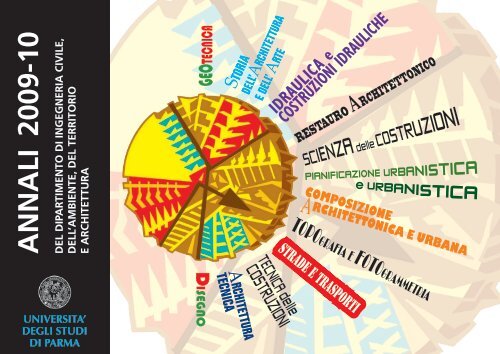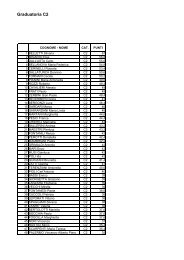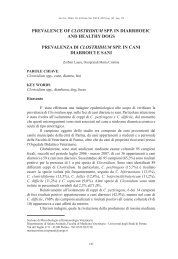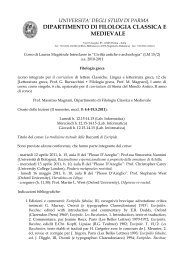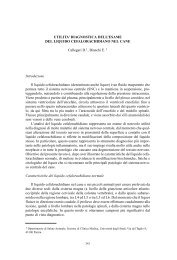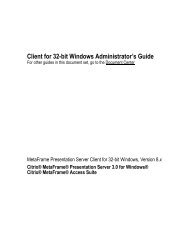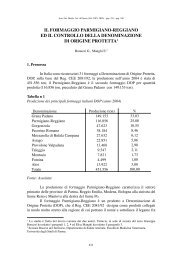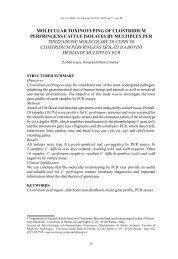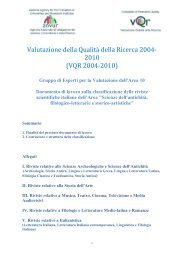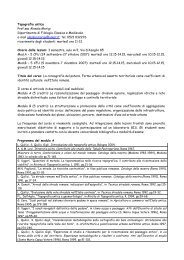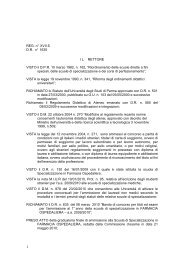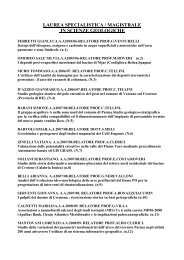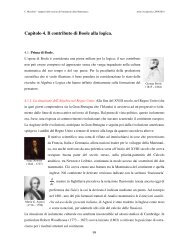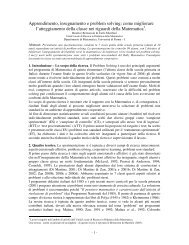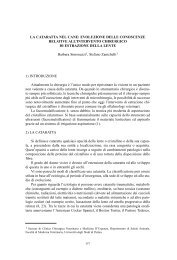ANNALI 2009-10 - Università degli Studi di Parma
ANNALI 2009-10 - Università degli Studi di Parma
ANNALI 2009-10 - Università degli Studi di Parma
You also want an ePaper? Increase the reach of your titles
YUMPU automatically turns print PDFs into web optimized ePapers that Google loves.
<strong>ANNALI</strong> <strong>2009</strong>-<strong>10</strong><br />
DEL DIPARTIMENTO DI INGEGNERIA CIVILE,<br />
DELL’AMBIENTE, DEL TERRITORIO<br />
E ARCHITETTURA<br />
GEOTECNICA<br />
STORIA<br />
DELL’ARCHITETTURA<br />
E DELL’ ARTE<br />
TECNICA delle<br />
IDRAULICA e<br />
COSTRUZIONI IDRAULICHE<br />
RESTAURO A RCHITETTONICO<br />
COMPOSIZIONE<br />
RCHITETTONICA E URBANA<br />
A<br />
SCIENZA delle COSTRUZIONI<br />
PIANIFICAZIONE URBANISTICA<br />
TOPOGRAFIA E FOTOGRAMMETRIA<br />
STRADE E TRASPORTI<br />
e URBANISTICA<br />
UNIVERSITA’<br />
DEGLI STUDI<br />
DI PARMA<br />
DISEGNO<br />
TECNICA<br />
ARCHITETTURA<br />
COSTRUZIONI
DIPARTIMENTO<br />
DI INGEGNERIA<br />
CIVILE,<br />
DELL’AMBIENTE<br />
DEL TERRITORIO<br />
E ARCHITETTURA<br />
( DICATeA )<br />
Direttore del Dipartimento<br />
Prof. Roberto Cerioni<br />
vice Direttore<br />
Prof. Carlo Mambriani<br />
Direttore del Laboratorio<br />
Prof. Andrea Carpinteri<br />
Componenti della Giunta<br />
Prof. Bruno Adorni<br />
Ing. Eva Coïsson<br />
Prof. Anna Maria Ferrero<br />
Prof. Felice Giuliani<br />
Prof. Andrea Spagnoli<br />
Prof.ssa Maria Giovanna Tanda<br />
Prof. Paolo Ventura<br />
Arch. Chiara Vernizzi<br />
Personale Tecnico-Amministrativo<br />
Dott. Davide Bompani<br />
Ing. Luca Chiapponi<br />
Rag. Stefano Gobbi<br />
Sig.ra Loredana Gentile<br />
Geom. Eustacchio Guatteri<br />
Per. Ind. Vittorio Leporati<br />
Geom. Giovanni Mingar<strong>di</strong><br />
Geom. Franco Montanari<br />
Il Dipartimento <strong>di</strong> Ingegneria Civile, dell’Ambiente, del Territorio<br />
e Architettura sviluppa attività <strong>di</strong> ricerca, <strong>di</strong> base ed applicata,<br />
teorica e sperimentale, nell’ambito della progettazione<br />
e delle tecniche <strong>di</strong> realizzazione delle costruzioni civili, delle<br />
infrastrutture viarie e delle opere <strong>di</strong> <strong>di</strong>fesa del territorio, nonché<br />
nell’ambito dell’urbanistica e dell’architettura.<br />
Ne fanno parte professori, ricercatori, assegnisti, borsisti e dottoran<strong>di</strong><br />
con competenze culturali e professionali nell’ambito<br />
dell’Ingegneria Civile, Ambientale e dell’Architettura, che forniscono<br />
la <strong>di</strong>dattica <strong>di</strong> <strong>di</strong>scipline inserite nei corsi <strong>di</strong> Laurea in<br />
Ingegneria Civile, in Ingegneria Ambientale e in Architettura<br />
dell’Ateneo <strong>di</strong> <strong>Parma</strong>.<br />
Le aree <strong>di</strong>sciplinari presenti nel <strong>di</strong>partimento sono così sintetizzate:<br />
Scienza e Tecnica delle Costruzioni, Infrastrutture<br />
viarie e Trasporti, Topografia e Fotogrammetria, Idraulica e<br />
Costruzioni Idrauliche, Geotecnica, Disegno, Composizione<br />
Architettonica, Architettura Tecnica, Restauro Architettonico,<br />
Urbanistica, Storia dell’Architettura.<br />
Nel <strong>di</strong>partimento sono stati condotti stu<strong>di</strong> nell’ambito <strong>di</strong> programmi<br />
<strong>di</strong> ricerca nazionali ed internazionali finanziati dal<br />
Ministero dell’Università e della Ricerca e dalla Comunità Europea<br />
e, in collaborazioni con numerose Università italiane,<br />
europee, <strong>degli</strong> Stati Uniti d’America e del Giappone. Tra queste<br />
si ricordano l’Imperial College <strong>di</strong> Londra, l’Università <strong>di</strong> Grenoble,<br />
il Politecnico <strong>di</strong> Losanna, l’Università Tecnica <strong>di</strong> Delft,<br />
l’Università del Minnesota.<br />
Il <strong>di</strong>partimento <strong>di</strong>spone <strong>di</strong> laboratori per prove sui materiali<br />
da costruzione (laterizi, conglomerati cementizi, conglomerati<br />
bituminosi, acciai), sulle strutture, sulle terre e rocce, nonché<br />
per prove su modelli fisici in scala nell’ambito dell’idraulica,<br />
delle costruzioni idrauliche e della geotecnica per la <strong>di</strong>fesa del<br />
territorio.<br />
The Department of Civil and Environmental Engineering and Architecture<br />
carries on basic and applied research activities regar<strong>di</strong>ng<br />
the design and the technique of realization of civil constructions,<br />
road infrastructures and works for territorial preservation,<br />
as well as regar<strong>di</strong>ng town planning and architecture.<br />
The Department includes professors and researches, with cultural and<br />
professional experience in Civil and Environmental Engineering and<br />
Architecture. The Department staff is involved in teaching activities<br />
at the Faculty of Engineering (courses of Civil Engineering and Environmental<br />
and Land Management Engineering) and at the Faculty of<br />
Architecture.<br />
The <strong>di</strong>sciplinary areas present in the Department are: Material and<br />
Structure Mechanics, Structures Design, Road Infrastructures, Surveying<br />
and Photogrammetry, Hydraulics and Hydraulic Constructions,<br />
Geotechnics, Drawing, Architectural Design, Architectural Technique,<br />
Architectural Restoration, Town Planning, History of Architecture.<br />
In the Department some stu<strong>di</strong>es of National and International research<br />
programs, supported by Italian Ministry of University and Research<br />
and European Community have been carried on. Some stu<strong>di</strong>es have<br />
been carried on in collaboration with other Italian, European, of U.S.A.<br />
and Japanese Universities (Imperial College of London, University of<br />
Grenoble, Polytechnic of Losanna, Delft University of Technology, University<br />
of Minnesota).<br />
The Department includes laboratories for tests on construction materials<br />
(clay bricks, concrete, bituminous conglomerate, steel), on structures,<br />
on soils and rocks, as well as tests on physical scaled models<br />
to investigate problems of Hydraulic Constructions, Geotechnics and<br />
Land Management.<br />
Vista delle palazzine del Dipartimento nella Sede scientifica <strong>di</strong> Ingegneria<br />
del Campus - Universitario <strong>di</strong> via Langhirano - <strong>Parma</strong>
ARCHITETTURA<br />
TECNICA<br />
Personale<br />
Ing. Agnese Ghini<br />
-Ricercatrice<br />
Arch. Barbara Gherri<br />
- Dottoranda <strong>di</strong> Ricerca<br />
L’attività <strong>di</strong> ricerca è finalizzata all’in<strong>di</strong>viduazione <strong>di</strong> soluzioni<br />
tecnologiche in grado <strong>di</strong> garantire un apporto antropico sostenibile<br />
dal punto <strong>di</strong> vista sociale e ambientale, elevate prestazioni<br />
<strong>di</strong> comfort interno e ridotti consumi <strong>di</strong> risorse non<br />
rinnovabili.<br />
Questi gli ambiti della ricerca:<br />
Progettazione sostenibile e misura dell’impatto ambientale dell’e<strong>di</strong>ficio<br />
Soluzioni progettuali per architetture a basso consumo <strong>di</strong> risorse<br />
non rinnovabili - bilancio energetico dell’involucro ed LCA<br />
Comfort interno. Verifiche - numeriche e sperimentali - <strong>di</strong> prestazioni<br />
ambientali termiche, igrometriche luminose e acustiche<br />
Bioclimatica: e<strong>di</strong>fici responsabile e climaticamente sensibili<br />
Soluzioni tecnologiche <strong>di</strong> involucro “ben temperato” – parete<br />
ventilata, parete ventilante, solare passivo, materiali e sistemi<br />
innovativi<br />
Attualmente, sono attive alcune convenzioni <strong>di</strong> ricerca sulle<br />
prestazioni termiche e igrometriche dell’involucro in tecnologia<br />
stratificata a secco <strong>di</strong> un ampio campione <strong>di</strong> e<strong>di</strong>fici a basso<br />
consumo energetico, realizzati in Europa nell’ultimo quinquennio;<br />
sul comportamento termico della parete ventilata<br />
a giunti chiusi in regime <strong>di</strong>namico e sul retrofit energetico <strong>di</strong><br />
e<strong>di</strong>fici appartenenti al patrimonio del social housing.<br />
Le verifiche de<strong>di</strong>cate vengono svolte per via numerica e sperimentale<br />
grazie al ricorso ad un prototipo realizzato in sede.<br />
In collaborazione con altri ambiti <strong>di</strong>sciplinari, è attiva una<br />
convenzione sulla<br />
definizione <strong>di</strong> un<br />
nuovo modello inse<strong>di</strong>ativo-produttivo<br />
sostenibile, autosufficiente<br />
energeticamente<br />
e a basso consumo<br />
<strong>di</strong> risorse non<br />
rigenerabili, self-reliant<br />
dal punto <strong>di</strong> vista<br />
alimentare.<br />
ARCHITECTURAL TECHNOLOGY<br />
The research activity is finalized to the development of technological solutions<br />
able to guarantee an anthropic input sustainable under the environmental<br />
and social point of view, high levels of indoor comfort related<br />
to low consumption of non-renewable resources.<br />
The research activity is mainly focused on:<br />
Sustainable design and environmental impact assessment for residential<br />
buil<strong>di</strong>ng Design solutions for low consumption house – envelope energy<br />
balance and LCA Indoor comfort. Theoretical methods and on-site experimental<br />
tests for thermal, hygrometric, daylighting and acoustic performances<br />
valuations<br />
Bioclimatic: responsive and climate sensitive buil<strong>di</strong>ngs<br />
Technological systems for “well tempered” envelope – ventilated walls,<br />
dynamic insulation walls, passive solar systems, innovative materials.<br />
Presently, a few research agreements are carried out: about thermal<br />
and hygrometric performances of “stratified” dry technology envelopes,<br />
adopted for a large sample of low energy buil<strong>di</strong>ngs constructed during<br />
last five years in Europe; about thermal behaviour of ventilated wall in<br />
dynamic summer con<strong>di</strong>tions; about energy retrofit of heritage of socialhousing.<br />
The verifications are performed by theoretical methods and on-site experimental<br />
tests using a prototype constructed on-site.<br />
In collaborations with other <strong>di</strong>sciplines, a research agreement about the<br />
definition of a sustainable productive-residential, self-energy and selfreliant<br />
settlement, is going on.<br />
Fig. 1 Fig. 2<br />
Figura 1<br />
Costruzione <strong>di</strong> un prototipo<br />
in area Campus per la<br />
verifica prestazionale termica<br />
ed igrometrica delle<br />
soluzioni tecnologiche <strong>di</strong><br />
involucro.<br />
Figura 2<br />
Inserimento <strong>di</strong> termoflussimetri<br />
per la valutazione<br />
del flusso termico passante<br />
attraverso l’involucro del<br />
prototipo<br />
1
STORIA<br />
DELL’ ARCHITETTURA<br />
E DELL’ARTE<br />
Personale<br />
Prof. Bruno Adorni<br />
-Professore Or<strong>di</strong>nario<br />
Prof. Carlo Mambriani<br />
-Professore Associato<br />
Prof. Elisabetta Fadda<br />
-Ricercatrice<br />
-Assegnista <strong>di</strong> Ricerca<br />
Prof. Sergio Bettini<br />
Collaborazioni<br />
- Convenzioni per il catalogo dei <strong>di</strong>segni<br />
accademici <strong>di</strong> architettura dell’Istituto<br />
d’Arte «P. Toschi» <strong>di</strong> <strong>Parma</strong><br />
- Accordo con l’Archivio del Moderno<br />
Accademia <strong>di</strong> Architettura <strong>di</strong> Mendrisio<br />
(CH) per lo stu<strong>di</strong>o delle maestranze<br />
e <strong>degli</strong> architetti ticinesi attivi nel<br />
Parmense in età moderna<br />
- Partecipazione al comitato scientifico<br />
del centro internazionale <strong>di</strong> stu<strong>di</strong><br />
“Jacopo Barozzi da Vignola”<br />
2<br />
La ricerca nel campo della storia dell’architettura e dell’arte è<br />
finalizzata a ricostruire congiunture e modalità <strong>di</strong> ideazione,<br />
produzione e decorazione <strong>degli</strong> e<strong>di</strong>fici e <strong>degli</strong> inse<strong>di</strong>amenti<br />
urbani e territoriali del passato.<br />
Pur occupandosi in maniera specialistica <strong>di</strong> manufatti<br />
architettonici e artistici, si tenta <strong>di</strong> inserirli nel loro contesto,<br />
nel pieno rispetto dell’unità della storia.<br />
Il gruppo <strong>di</strong> lavoro è composto da tre docenti strutturati, un<br />
assegnista <strong>di</strong> ricerca e <strong>di</strong>versi docenti a contratto. I principali<br />
temi d’indagine riguardano l’architettura emiliana <strong>di</strong> età<br />
moderna e contemporanea, stu<strong>di</strong>ata sia attraverso analisi a<br />
tutto campo <strong>di</strong> un contesto o <strong>di</strong> una stagione, sia attraverso<br />
stu<strong>di</strong> monografici de<strong>di</strong>cati a singoli e<strong>di</strong>fici, protagonisti,<br />
episo<strong>di</strong>.<br />
In prospettiva, si vorrebbe giungere a una sorta <strong>di</strong> catalogo<br />
sempre più esaustivo <strong>di</strong> stu<strong>di</strong> aggiornati sull’architettura, la<br />
città e il territorio dell’area in oggetto, per contribuire a una<br />
miglior comprensione storica delle caratteristiche del luogo,<br />
allargando via via lo sguardo verso temi contigui non soltanto<br />
a livello geografico ma anche culturale.<br />
Nell’ultimo triennio, il gruppo <strong>di</strong> ricerca si è occupato <strong>di</strong><br />
architettura farnesiana a <strong>Parma</strong>, delle chiese <strong>di</strong> Santa Maria<br />
della Steccata e <strong>di</strong> Santa Maria del Quartiere, del complesso<br />
delle Certose <strong>di</strong> Pavia e <strong>di</strong> <strong>Parma</strong>, <strong>di</strong> varie residenze private,<br />
<strong>di</strong> storia del giar<strong>di</strong>no, del tema della luce nell’architettura del<br />
passato.<br />
ARCHITECTURE AND ART HISTORY<br />
Our research in the field of the history of art and architecture aims to reconstruct<br />
links and the ways in which buil<strong>di</strong>ngs and urban settlements<br />
in the past were conceived, built and decorated. Without renouncing the<br />
specialist’s approach to studying buil<strong>di</strong>ngs of architectural and artistic<br />
value, we try to place them in their cultural and political context, considering<br />
the unity of history that influenced any of their characteristics.<br />
The research group is made up of three tenured faculty, one postdoctoral<br />
fellow and several adjunct faculty.<br />
Our main field of investigation is contemporary and modern Emilian<br />
architecture, stu<strong>di</strong>ed either with a wide approach to a theme or a period,<br />
or with a monographic focus de<strong>di</strong>cated to single buil<strong>di</strong>ngs, protagonists,<br />
or episodes.<br />
As a future goal, we would like to construct a catalogue that is an ever<br />
more complete record of this territory.
PIANIFICAZIONE<br />
URBANISTICA,<br />
del PAESAGGIO e<br />
del TERRITORIO<br />
Personale<br />
Prof.Arch. Paolo Ventura<br />
-Professore Or<strong>di</strong>nario<br />
Ing. Michele Zazzi<br />
-Ricercatore<br />
- Assegnista <strong>di</strong> Ricerca<br />
Arch.Damianos Damianakos<br />
- Dottorando <strong>di</strong> Ricerca<br />
Arch. Simone Riccar<strong>di</strong><br />
Le collaborazioni sono con centri e<br />
stu<strong>di</strong> <strong>di</strong> ricerca delle seguenti nazioni:<br />
Belgio, Francia, Svizzera, Algeria,<br />
Cecoslovacchia, Ungheria, Germania,<br />
Finlan<strong>di</strong>a, Norvegia, Svezia, Russia,<br />
Turchia, Russia, USA) e nazionale<br />
(in particolare con università delle<br />
seguenti città: Bologna, Brescia,<br />
Firenze, Milano Politecnico, Reggio<br />
Calabria, Roma).<br />
Il gruppo <strong>di</strong> lavoro, formato da docenti, ricercatori, dottoran<strong>di</strong><br />
e assegnisti <strong>di</strong> ricerca e riunito nel Laboratorio <strong>di</strong> Urbanistica,<br />
Paesaggio e Territorio (www.urbanistica.unipr.it) promuove l’approfon<strong>di</strong>mento<br />
e lo sviluppo <strong>di</strong> forme innovative e inter<strong>di</strong>sciplinari<br />
per la <strong>di</strong>dattica e la ricerca nelle materie urbanistiche, alla<br />
scala nazionale e internazionale, con significativo interesse per il<br />
territorio me<strong>di</strong>o padano.<br />
Le principali linee <strong>di</strong> ricerca riguardano i seguenti filoni:<br />
1) stu<strong>di</strong> e ricerche riguardanti la definizione <strong>di</strong> politiche a livello<br />
internazionale per lo sviluppo urbanistico sostenibile <strong>di</strong> comunità<br />
minori svantaggiate;<br />
2) stu<strong>di</strong> e ricerche riguardanti la pianificazione territoriale e urbanistica.<br />
In particolare sono in atto stu<strong>di</strong> per lo sviluppo della<br />
città <strong>di</strong> Ekaterinburg (Urali, Federazione Russa);<br />
3) stu<strong>di</strong> e progetti riguardanti l’organizzazione urbanistica delle<br />
attività secondarie, terziarie e quaternarie, con speciale attenzione<br />
per la riqualificazione <strong>degli</strong> inse<strong>di</strong>amenti produttivi, lo<br />
sviluppo e la valorizzazione dei centri commerciali naturali, il<br />
progetto dei parchi scientifici e tecnologici;<br />
4) stu<strong>di</strong> e ricerche riguardanti i modelli della progettazione urbanistica<br />
e dell’urbanistica virtuale. Tali stu<strong>di</strong> sono condotti nella<br />
prospettiva <strong>di</strong> offrire strumenti <strong>di</strong> conoscenza, gestione critica,<br />
riqualificazione <strong>degli</strong> inse<strong>di</strong>amenti esistenti e corretto nuovo<br />
progetto <strong>di</strong> nuove ad<strong>di</strong>zioni urbane.<br />
I componenti del gruppo <strong>di</strong> ricerca sono, inoltre, specializzati nei<br />
seguenti campi <strong>di</strong> interesse:<br />
- definizione <strong>di</strong> in<strong>di</strong>catori <strong>di</strong> qualità dello spazio pubblico nella<br />
periferia delle città contemporanee;<br />
- analisi preliminari per i piani <strong>di</strong> centri storici;<br />
- redazione <strong>di</strong> inventari del patrimonio immobiliare <strong>di</strong> enti territoriali.<br />
- pianificazione sostenibile con speciale riguardo alle esigenze<br />
dei bambini e delle bambine;<br />
- piani <strong>di</strong> moderazione del traffico;<br />
- piani intercomunali;<br />
- piani <strong>di</strong> restauro <strong>di</strong> parchi storici;<br />
- piani per l’in<strong>di</strong>viduazione <strong>di</strong> aree cuscinetto dei parchi;<br />
- gestione del paesaggio;<br />
- pianificazione dei bacini idrografici.<br />
TOWN, COUNTRY AND LANDSCAPE PLANNING<br />
This branch of the Department (www.urbanistica.unipr.it) explores and develops<br />
innovative, inter<strong>di</strong>sciplinary forms of teaching and researching town<br />
planning and landscape planning and design at international and national<br />
level, with particular attention to the middle Po valley.<br />
The following are the areas of research that have been of greatest interest to<br />
the working group in recent years:<br />
1) study and research on the definition of international-level town planning<br />
policies which are sustainable for minor deprived communities;<br />
2) study and research on town and country planning, and in particular<br />
stu<strong>di</strong>es presently being carried out on the development of the city of Ekaterinburg<br />
(Urals, Russian Federation);<br />
3) study and projects on how secondary, tertiary and quaternary activities<br />
should be organised within town planning especially as regards the reconversion<br />
of industrial buil<strong>di</strong>ngs, the development and enhancement of natural<br />
shopping centres and science and technology parks;<br />
4) study and research on town planning and virtual town planning models<br />
in order to devise tools for acquiring knowledge, a critical approach, the<br />
reconversion of existing facilities and a proper approach to planning ad<strong>di</strong>tions<br />
to the city.<br />
Furthermore, the actual research and study projects carried out mainly on<br />
behalf of national and international public bo<strong>di</strong>es qualify the members of<br />
the research group as specialists in the following fields:<br />
- defining quality in<strong>di</strong>cators for public areas in the outskirts of contemporary<br />
cities;<br />
- conducting preliminary analyses towards inner-city planning;<br />
- surveying and inventorying the property owned by local bo<strong>di</strong>es;<br />
- sustainable planning with special regard to the needs of children;<br />
- planning traffic moderation;<br />
- inter-municipality planning;<br />
- planning the restoration of historic parks;<br />
- planning the identification<br />
of park buffer areas;<br />
- landscape management;<br />
- catchment basin<br />
management.<br />
3
URBAN AND<br />
ARCHITECTURAL<br />
COMPOSITION<br />
a destra<br />
Il museo<br />
del Louvre<br />
a Parigi.<br />
al centro<br />
Il paesaggio <strong>di</strong> Torrechiara.<br />
sotto<br />
la via Emilia.<br />
FESTIVAL OF ARCHITECTURE<br />
Founded in 2004, under the scientific <strong>di</strong>rection of Prof. Carlo<br />
Quintelli, currently in its fifth e<strong>di</strong>tion, de<strong>di</strong>cated to the theme of<br />
Community-architecture, the Festival dell’Architettura (www.festivalarchitettura.it)<br />
is recognised on an international level.<br />
This is a manifestation featuring both scientific research and the<br />
tables, exhibitions and workshops, with prizes and competitions<br />
linked to the themes of the research and the various workshop<br />
activities; the latter being supervised by young researchers belonging<br />
to <strong>di</strong>fferent Faculties of Architecture both in Italy and abroad.<br />
The Festival it has availed itself over the years of important collaborations<br />
with scientific bo<strong>di</strong>es and institutions.<br />
SETTLEMENT SYSTEM OF THE VIA EMILIA,<br />
understood as an ambit of interpretative and planning experimentation<br />
centred on the infrastructure-architecture relationship<br />
in its multi-scale meaning, involving places, city, and territory.<br />
Within this sphere, long defined CITTAEMILIA, the research,<br />
developed under the scientific <strong>di</strong>rection of Prof. Carlo Quintelli,<br />
along the western stretch of the consular road, have evolved stu<strong>di</strong>es<br />
on structure, character and the phenomenology of becoming the<br />
Via Emilia. This has meant defining a functional methodological<br />
structure to garner the heterogeneity of the settlement phenomena<br />
involved, accor<strong>di</strong>ng to intervention criteria which are simultaneously<br />
systematic and non-modellistic.<br />
RESEARCH PRIN PUBLIC BUILDING FOR CULTURE<br />
The theme of <strong>Parma</strong> Research group, under the scientific <strong>di</strong>rection<br />
of Prof. Aldo De Poli, “The architectural model of University City campus.<br />
<strong>Parma</strong>: Critical evaluations and Experimental verifications”, inside<br />
PRIN 2007, Program of Scientific research of significant national interest,<br />
coor<strong>di</strong>nated by D. Vitale, Politecnico <strong>di</strong> Milano, entitled “Criteria and<br />
requirements for University settlement. Conversion of historic urbanisations<br />
and new actions”. The first unit is formed by A. De Poli, A. Ghini,<br />
C. Visentin, M. Bruzzone, S. Ombellini, R. Borghi, with M. Amarante e<br />
B. Gherri. The second unit, formed by L. Vacchelli, A. Massera and M.<br />
Casanovi, aims to promote exchanges with other European universities,<br />
inclu<strong>di</strong>ng TU Delft Polytechnic and ENSA Paris-Malaquais.<br />
RESEARCH ARCHITECTURE, LANDSCAPE AND PLACE IDENTITY<br />
The program promoted under the scientific <strong>di</strong>rection of Prof. Aldo De<br />
Poli e Chiara Visentin, with F. Arman, in collaboration with Istituto Alcide<br />
Cervi-Library and Archives Emilio Sereni of Gattatico, announces<br />
significant meeting-days in Gattatico, on the themes of Architecture and<br />
Landscape. The common thread is the valorization of architecture, city<br />
and cultural heritage of Emilia.<br />
RESEARCH ARCHITECTURE MUSEUMS NETWORKS<br />
The Research Architecture Museums Networks (architetturamuseireti.<br />
it), under the scientific <strong>di</strong>rection of Prof. A. De Poli, with M. Bruzzone,<br />
R. Borghi, F. Arman e M. Amarante, ICOM-Italy members, deepens<br />
themes on museum and exhibit design, collects scientific documentation,<br />
e<strong>di</strong>ts catalogues and organizes international meeting-days.<br />
The main events of <strong>2009</strong> are the conferences “L’esporre e il ricordare<br />
nell’architettura dei BBPR” in Carpi (Modena) and “I musei. Ricerca<br />
Formazione Reti” in <strong>Parma</strong>.<br />
4
COMPOSIZIONE<br />
ARCHITETTONICA<br />
E URBANA<br />
Personale<br />
Prof. Arch. Aldo De Poli<br />
- Professore Or<strong>di</strong>nario<br />
Prof. Arch. Carlo Quintelli<br />
- Professore Or<strong>di</strong>nario<br />
Arch. Dario Costi<br />
-Ricercatore<br />
Arch. Enrico Pran<strong>di</strong><br />
-Ricercatore<br />
- Dottoran<strong>di</strong> <strong>di</strong> Ricerca<br />
Arch. Maria Amarante<br />
Arch. Federica Arman<br />
Arch. Roberta Borghi<br />
- Assegnisti <strong>di</strong> Ricerca<br />
Arch. Chiara Visentin<br />
Arch. Monica Bruzzone<br />
FESTIVAL DELL’ARCHITETTURA<br />
Nato nel 2004, con la <strong>di</strong>rezione scientifica del Prof. Carlo Quintelli,<br />
attualmente alla quinta e<strong>di</strong>zione (<strong>2009</strong>-20<strong>10</strong>) de<strong>di</strong>cata al<br />
tema Comunità-Architettura, il Festival dell’Architettura (www.<br />
festivalarchitettura.it) è un evento <strong>di</strong> ricerca e <strong>di</strong>vulgazione sui temi<br />
dell’Architettura con sede a <strong>Parma</strong>, Reggio e Modena. Segnalato<br />
tra una selezione <strong>di</strong> eventi internazionali d’architettura nel “The<br />
Skira Yearbook of World architecture 2007-2008” è stato oggetto<br />
<strong>di</strong> analisi nel libro-censimento sui festival <strong>di</strong> approfon<strong>di</strong>mento<br />
culturale “Effetto festival“ <strong>di</strong> Guido Guerzoni (2008). E’ costituito<br />
da lectio magistralis, conferenze, tavole rotonde, mostre, workshop,<br />
premi e concorsi legati ai temi <strong>di</strong> ricerca e alle <strong>di</strong>fferenti<br />
attività laboratori ali curate, quest’ultime, da giovani ricercatori<br />
appartenenti a <strong>di</strong>verse Facoltà <strong>di</strong> Architettura italiane e straniere.<br />
Il Festival si è avvalso negli anni <strong>di</strong> importanti collaborazioni<br />
con enti e istituzioni come il CCA <strong>di</strong> Montréal, Fondation Le<br />
Corbusier, GAM <strong>di</strong> U<strong>di</strong>ne, Dottorato in Composizione Architettonica<br />
<strong>di</strong> Venezia, oltre che del supporto del Comune <strong>di</strong> <strong>Parma</strong>,<br />
Reggio Emilia, Modena, delle relative Province, della Regione<br />
Emilia Romagna e <strong>degli</strong> Enti <strong>di</strong> Categoria.<br />
SISTEMA INSEDIATIVO DELLA VIA EMILIA<br />
La ricerca, con la <strong>di</strong>rezione scientifica del Prof. Carlo Quintelli, si<br />
concentra sul rapporto infrastruttura-architettura in un’accezione<br />
multiscalare coinvolgente luoghi, città, territorio.<br />
Nell’ambito <strong>di</strong> ricerca, da tempo definito CITTAEMILIA nel<br />
tratto occidentale della strada consolare, si sono evoluti gli stu<strong>di</strong><br />
su struttura, caratteri e fenomenologia del <strong>di</strong>venire della Via<br />
Emilia, a partire dagli esiti <strong>di</strong> ricerca sintetizzati nel volume “La<br />
strada ritrovata: Problemi e prospettive dell’architettura della<br />
Via Emilia” <strong>Parma</strong> 2005. Si è trattato <strong>di</strong> definire una struttura<br />
metodologica funzionale a cogliere l’eterogeneità dei fenomeni<br />
inse<strong>di</strong>ativi coinvolti, secondo criteri <strong>di</strong> intervento al tempo stesso<br />
sistematici e non modellistici. Tali <strong>Stu<strong>di</strong></strong> hanno trovato soluzioni<br />
applicative nell’ambito dell’elaborazione del PSC <strong>di</strong> Reggio Emilia<br />
e nel Laboratorio della Città <strong>di</strong> Modena attraverso il rapporto<br />
convenzionato con i rispettivi Comuni. Ulteriori risvolti sperimentali<br />
riguardano il progetto Giornata Tributo Via Emilia, incollaborazione<br />
con Regione Emilia Romagna nonché Comuni e<br />
Province afferenti alla strada, da Fidenza a Castelfranco Emilia.<br />
RICERCA EDIFICI PER LA CULTURA PRIN 07<br />
Il tema dell’unità <strong>di</strong> <strong>Parma</strong>, con la <strong>di</strong>rezione scientifica del Prof.<br />
Aldo De Poli, è “Il modello architettonico della Città Universitaria.<br />
<strong>Parma</strong>: valutazioni critiche e verifiche sperimentali”, del<br />
Programma <strong>di</strong> ricerca scientifica <strong>di</strong> rilevante interesse nazionale,<br />
Anno 2007, prot. 2007FMF9BL_003, coor<strong>di</strong>nato dal prof. D. Vitale,<br />
Politecnico <strong>di</strong> Milano, intitolato “Criteri e requisiti dell’e<strong>di</strong>lizia<br />
universitaria. Trasformazione <strong>di</strong> inse<strong>di</strong>amenti storici e nuovi<br />
interventi”.<br />
Una prima unità è formata da A. De Poli, A. Ghini, C. Visentin,<br />
M. Bruzzone, S. Ombellini e R. Borghi, con M. Amarante<br />
e B. Gherri. Ad essa si affianca una seconda unità, formata da<br />
L. Vacchelli, A. Massera e M. Casanovi, per progetti <strong>di</strong> scambio<br />
con altre se<strong>di</strong> europee, quali il Politecnico <strong>di</strong> Delft e l’Ensa Paris-<br />
Malaquais <strong>di</strong> Parigi.<br />
RICERCA ARCHITETTURA, PAESAGGIO<br />
E IDENTITA’ DEL LUOGO<br />
Il programma, con la <strong>di</strong>rezione scientifica del Prof. Aldo De Poli<br />
e Chiara Visentin, con F. Arman, in collaborazione con l’Istituto<br />
Alcide Cervi e Biblioteca - Archivio Emilio Sereni <strong>di</strong> Gattatico<br />
(Reggio Emilia), attua una convenzione <strong>di</strong> ricerca su Architettura<br />
e Paesaggio.<br />
Il filo conduttore è la valorizzazione dell’architettura e del patrimonio<br />
culturale dell’Emilia. Le giornate <strong>di</strong> stu<strong>di</strong>o si tengono a<br />
Gattatico e presentano nuovi stu<strong>di</strong> sul territorio, sulla città e sulla<br />
casa in Emilia.<br />
RICERCA ARCHITETTURA MUSEI RETI<br />
La ricerca Architettura Musei Reti (www.architetturamuseireti.it),<br />
con <strong>di</strong>rezione scientifica del Prof. Aldo De Poli, con M. Bruzzone,<br />
R. Borghi, F. Arman e M. Amarante, approfon<strong>di</strong>sce temi inerenti<br />
l’architettura dei musei, l’allestimento e la museografia, raccoglie<br />
documentazione scientifica, cura pubblicazioni e cataloghi e organizza<br />
giornate <strong>di</strong> stu<strong>di</strong>o internazionali <strong>di</strong> confronto.<br />
Tra le iniziative il Convegno “L’esporre e il ricordare nell’architettura<br />
dei BBPR”, tenuto a Carpi (Modena) e il Convegno “I musei.<br />
Ricerca Formazione Reti”, organizzato a <strong>Parma</strong> nel <strong>2009</strong>.<br />
5
DRAWING<br />
The research underway in the scientific-<strong>di</strong>sciplinary group “ICAR 17<br />
– Drawing” at the DICATeA, is characterized by joint testing of methods<br />
and techniques of research and tra<strong>di</strong>tional and <strong>di</strong>gital representation by<br />
the use of software and specific information systems.<br />
In particular, the research is articulated in the study of the structuring<br />
of urban image along the major urban and suburban streets and survey<br />
and representation, through <strong>di</strong>fferent techniques, systems and infrastructure<br />
architectural complex in <strong>Parma</strong>. The research combines historical<br />
iconographical archive research, <strong>di</strong>rect measurements and methods<br />
and tools for acquiring advanced technologies and three-<strong>di</strong>mensional<br />
<strong>di</strong>gital representation.<br />
The research is developed mainly in the areas of urban and environmental<br />
significance and importance of architecture, in which, starting from<br />
<strong>di</strong>mensional geometric data of the architectural and urban elements,<br />
(buil<strong>di</strong>ngs, pathways, spaces Urban), through a representation of them<br />
in the appropriate scale of reduction, territorial, urban and architectural<br />
design, trying to capture and highlight the formal aspects and volumetric<br />
features.<br />
This research contributes to the definition of methodological procedures<br />
for the monitoring of the city and the environment, in order to build a<br />
system of control over the actions of environmental regeneration, urban<br />
and architectural design, through the identification of a structure relationship<br />
that could set up as a system suitable to the management of processes<br />
at <strong>di</strong>fferent scales of intervention, taking advantage of the survey<br />
and representation as the basic operational tools that set the subsequent<br />
management of data.<br />
A series of national and international research projects on these issues<br />
has been undertaken. These projects include:<br />
- The importance of the amphitheater Durrës: knowledge of a monument<br />
for the enhancement of world cultural heritage<br />
- Analysis and <strong>di</strong>agnosis of damaged structures of the Citadel of Damascus<br />
- The definition of a GIS for the identification, knowledge and study of<br />
places abandoned and containers available in the city of <strong>Parma</strong><br />
- Training of the Information System (SIPESC) for the management of<br />
municipal school buil<strong>di</strong>ngs<br />
- Architectural surveys and assessments on the state and the degradation<br />
of the church of Santa Maria del Quartiere in <strong>Parma</strong><br />
- Preliminary analysis and identification of guidelines for the implementation<br />
of a plan for the development of commercial natural center<br />
(CCN) in Oltretorrente and in the Old Town.<br />
6
DISEGNO<br />
Personale<br />
Prof.<br />
Arch. Paolo Giandebiaggi<br />
- Professore Or<strong>di</strong>nario<br />
Arch. Maria Evelina Melley<br />
- Ricercatrice<br />
Arch. Chiara Vernizzi<br />
- Ricercatrice<br />
Arch. Andrea Zerbi<br />
- Ricercatore<br />
- Assegnisti <strong>di</strong> Ricerca<br />
Arch. Ilaria Fioretti<br />
Arch. Andrea Ghiretti<br />
Arch. Daniela Paltrinieri<br />
Arch. Cecilia Tedeschi<br />
- Dottoran<strong>di</strong> <strong>di</strong> Ricerca<br />
Arch. Erika Alberti<br />
Arch. Donatella Bontempi<br />
Le ricerche in corso nell’ambito del Disegno, presso il Dipartimento<br />
si caratterizzano per la sperimentazione congiunta <strong>di</strong><br />
meto<strong>di</strong> e tecniche <strong>di</strong> ricerca e <strong>di</strong> rappresentazione tra<strong>di</strong>zionali<br />
e tecniche <strong>di</strong> rappresentazione informatiche, attraverso l’uso<br />
<strong>di</strong> software e sistemi informativi specifici.<br />
In particolare, le ricerche si articolano nello stu<strong>di</strong>o della strutturazione<br />
dell’immagine urbana percepibile lungo i percorsi<br />
urbani ed extraurbani principali e nel rilievo e nella rappresentazione<br />
attraverso tecniche <strong>di</strong>verse, <strong>di</strong> sistemi architettonici<br />
ed infrastrutturali complessi presenti in <strong>Parma</strong>, conciliando<br />
ricerche storico-iconografiche d’archivio, rilievi <strong>di</strong>retti<br />
e meto<strong>di</strong> <strong>di</strong> analisi e strumenti <strong>di</strong> acquisizione avanzata e tecniche<br />
<strong>di</strong> rappresentazione tri<strong>di</strong>mensionale <strong>di</strong>gitale.<br />
L’attività <strong>di</strong> ricerca si sviluppa prevalentemente nei settori<br />
del rilievo urbano ed ambientale e del rilievo dell’architettura,<br />
nei quali a partire dall’acquisizione dei dati geometrici e<br />
<strong>di</strong>mensionali <strong>degli</strong> elementi architettonici, urbani e paesaggistici<br />
componenti la città (e<strong>di</strong>fici, percorsi, spazi urbani), si<br />
procede ad una loro rappresentazione alle opportune scale <strong>di</strong><br />
riduzione, territoriale, urbana ed architettonica, cercando <strong>di</strong><br />
cogliere ed evidenziare gli aspetti formali e volumetrici caratteristici.<br />
Questo tipo <strong>di</strong> ricerca contribuisce alla definizione <strong>di</strong> procedure<br />
<strong>di</strong> carattere metodologico sul monitoraggio dell’architettura,<br />
della città e dell’ambiente, al fine <strong>di</strong> costituire un sistema<br />
<strong>di</strong> controllo negli interventi <strong>di</strong> riqualificazione ambientale,<br />
urbana ed architettonica, attraverso l’in<strong>di</strong>viduazione <strong>di</strong> una<br />
struttura relazionale che possa costituirsi come sistema informativo<br />
idoneo alla gestione dei processi <strong>di</strong> trasformazione<br />
alle <strong>di</strong>verse scale d’intervento, avvalendosi del rilievo e della<br />
rappresentazione come strumenti operativi <strong>di</strong> base su cui impostare<br />
la successiva gestione dei dati.<br />
Su questi temi si è preso parte ad una serie <strong>di</strong> progetti <strong>di</strong> ricerca<br />
nazionale ed internazionale tra cui si citano in particolare:<br />
- Il rilievo dell’anfiteatro <strong>di</strong> Durazzo: conoscenza <strong>di</strong> un monumento<br />
per la valorizzazione del patrimonio culturale mon<strong>di</strong>ale<br />
- Analisi e <strong>di</strong>agnosi delle strutture danneggiate della Cittadella<br />
<strong>di</strong> Damasco<br />
- La definizione <strong>di</strong> un sistema informativo per l’in<strong>di</strong>viduazione,<br />
la conoscenza e lo stu<strong>di</strong>o dei luoghi <strong>di</strong>smessi o in via <strong>di</strong><br />
<strong>di</strong>smissione e dei contenitori <strong>di</strong>sponibili nella città <strong>di</strong> <strong>Parma</strong><br />
- Formazione del sistema informativo (S.I.P.E.S.C.) per la gestione<br />
del patrimonio e<strong>di</strong>lizio scolastico comunale<br />
- Rilievi architettonici e valutazioni sulla situazione statica e<br />
<strong>di</strong> degrado della chiesa <strong>di</strong> Santa Maria del Quartiere in <strong>Parma</strong><br />
- Analisi preliminare e in<strong>di</strong>viduazione <strong>di</strong> linee guida per l’attuazione<br />
<strong>di</strong> un piano <strong>di</strong> sviluppo dei centri commerciali naturali<br />
(CCN) Oltretorrente e Centro Storico<br />
7
GEOTECHNICS<br />
The priority scientific topics of the research activities of the geotechnical<br />
group, involved in these projects, are:<br />
1. Rockfall<br />
2. Rock slope numerical modeling<br />
3. Hard soil – Soft Rock Characterization<br />
4. Mechanical behavior of natural <strong>di</strong>scontinuity in rock<br />
5. Numerical modeling of rock <strong>di</strong>scontinuities behavior<br />
6. Large mass movements<br />
7. Slope stability analysis of submerged volcanic structures<br />
8. Debris flow analysis and modeling<br />
9. Control and monitoring of the stability con<strong>di</strong>tion of the excavation<br />
The activity of the <strong>Parma</strong> University research group would mainly devoted<br />
to the development and application of slope modeling methods, in<br />
the geological and geotechnical characterization of materials involved<br />
in instability phenomena and control and monitoring of the stability<br />
con<strong>di</strong>tion of the excavation. This characterization will be done by means<br />
of specific in situ surveys and lab and in situ tests.<br />
The research group have been involved in several researches concerning<br />
<strong>di</strong>fferent aspects of rock fall phenomena for many years.<br />
In particular, blocks detachment evaluation on the basis of statistical and<br />
deterministic surveys, blocks movement analysis and modeling by means<br />
in situ tests interpretations and by improvements of a modeling code,<br />
block failure phenomenon at slope impact study and modeling, analysis<br />
of the dynamical behavior of protection system components developed by<br />
full tests physical models.<br />
Slope stability analysis of hard soil / weak rock materials is very peculiar<br />
and involved the determination of the mechanical behavior of these<br />
materials. For this reason a specific characterization by means of laboratory<br />
testing and on site surveys have to be carried out.<br />
Large mass movement phenomena involves the understan<strong>di</strong>ng of the<br />
failure mechanisms and triggering causes determination. The process<br />
involve the setting up of on site monitoring stations and the development<br />
of physical and numerical models.<br />
Risk assessment, safety and working environment issues are important<br />
consideration in undertaking excavation both for civil or mining purposes.<br />
A great effort in the research is performed by this group in the field<br />
of developing monitoring and alarming systems which can pre<strong>di</strong>ct, assess<br />
and minimize the risk during excavation.<br />
Modello Numerico agli Elementi <strong>di</strong><br />
Contorno <strong>di</strong> una galleria mineraria<br />
Boundary Element numerical model of<br />
an underground mine ( Fig. 1 )<br />
Fig. 1 Fig. 2<br />
Modello <strong>di</strong>gitale della superficie rugosa<br />
<strong>di</strong> un giunto in roccia<br />
Digital model of the rough surface of a<br />
rock joint ( Fig. 2 )<br />
Carota recuperata da un sondaggio a<br />
seguito dell’esecuzione <strong>di</strong> una prova<br />
CSIRO<br />
Borehole core recovered after the execution<br />
of a CSIRO on site test ( Fig. 3 )<br />
Fig. 3 Fig. 4<br />
Grafico dei risultati ottenuti da una<br />
prova <strong>di</strong> taglio ciclico su <strong>di</strong>scontinuità<br />
rugose<br />
Diagram of the results of a cyclic shear<br />
test on rough <strong>di</strong>scontinuities ( Fig. 4 )<br />
8
GEOTECNICA<br />
Personale<br />
Prof.<br />
Ing. Anna Maria Ferrero<br />
- Professore Associato<br />
Prof.<br />
Ing. Lorella Montrasio<br />
- Professore Associato<br />
Ing. Andrea Segalini<br />
- Ricercatore<br />
- Dottoran<strong>di</strong> <strong>di</strong> Ricerca<br />
Ing. Marco d’Attoli<br />
Ing. Gianluca Losi<br />
- Assegnisti <strong>di</strong> Ricerca<br />
Ing. Maria Rita Migliazza<br />
Ing. Roberto Valentino<br />
Le attività <strong>di</strong> ricerca <strong>degli</strong> appartenenti al gruppo vertono in<br />
numerosi settori della Geotecnica e Geomeccanica <strong>di</strong> seguito<br />
sinteticamente descritti, testimoniate da numerose pubblicazioni<br />
su riviste internazionali e nazionali <strong>di</strong> settore delle quali<br />
se ne allegano alcune ritenute particolarmente significative.<br />
In particolare gli argomenti <strong>di</strong> ricerca in cui il gruppo è stato<br />
maggiormente interessato negli anni 2007-2008 hanno riguardato:<br />
Analisi e modellazioni per la stabilità <strong>di</strong> scavi in sotterraneo<br />
Analisi e modellazioni per la stabilità <strong>di</strong> pen<strong>di</strong>i naturali e fronti<br />
<strong>di</strong> scavo<br />
<strong>Stu<strong>di</strong></strong>o del comportamento meccanico <strong>di</strong> materiali lapidei e <strong>di</strong><br />
<strong>di</strong>scontinuità in roccia<br />
Sviluppo <strong>di</strong> meto<strong>di</strong> innovativi <strong>di</strong> rilievo e monitoraggio <strong>degli</strong><br />
ammassi rocciosi<br />
<strong>Stu<strong>di</strong></strong>o e modellazione <strong>di</strong> fenomeni franosi indotti da piogge<br />
(soil-slip)<br />
Stabilità delle opere monumentali in relazione al comportamento<br />
delle fondazioni<br />
Messa a punto <strong>di</strong> tecnologie innovative per il settore<br />
geotecnico<br />
Il gruppo ha condotto numerosi stu<strong>di</strong> per analizzare <strong>di</strong>verse<br />
problematiche connesse con la realizzazione <strong>di</strong> scavi in sotterraneo,<br />
con particolare riguardo a:<br />
• applicazione <strong>di</strong> modelli continui e/o <strong>di</strong>scontinui per lo stu<strong>di</strong>o<br />
<strong>di</strong> ammassi rocciosi;<br />
• l’analisi del campo <strong>di</strong> tensione e deformazione indotto dallo<br />
scavo <strong>di</strong> gallerie e l’influenza dell’utilizzo <strong>di</strong> sistemi <strong>di</strong> sostegno<br />
e/o rinforzo;<br />
• le problematiche <strong>di</strong> stabilità connesse con la realizzazione<br />
<strong>di</strong> grosse camere sotterranee per la coltivazione <strong>di</strong> pietre ornamentali;<br />
• gli effetti <strong>di</strong> ce<strong>di</strong>menti superficiali indotti dallo scavo <strong>di</strong> gallerie<br />
metropolitane realizzate in terreni sciolti con macchine EPB.<br />
Per quel che concerne l’analisi <strong>di</strong> stabilità <strong>di</strong> versanti: si sono<br />
messe a punto metodologie <strong>di</strong> analisi per lo stu<strong>di</strong>o <strong>di</strong> fenomeni<br />
<strong>di</strong> ribaltamento, scivolamento e caduta <strong>di</strong> massi da pen<strong>di</strong>i<br />
in roccia e <strong>di</strong> scivolamento <strong>di</strong> pen<strong>di</strong>i in terra.<br />
In quest’ambito sono state condotte ricerche per lo stu<strong>di</strong>o e la<br />
modellazione <strong>di</strong> fenomeni franosi indotti da piogge (soil-slip)<br />
implementando uno specifico modello <strong>di</strong> calcolo e applicandolo<br />
a numerosi casi reali.<br />
Gli stu<strong>di</strong> teorici e sperimentali per la classificazione <strong>degli</strong> ammassi<br />
rocciosi e per la determinazione del comportamento<br />
meccanico <strong>degli</strong> ammassi hanno riguardato in particolare lo<br />
sviluppo <strong>di</strong> tecniche <strong>di</strong> acquisizione e trattamento dei dati per<br />
la classificazione <strong>di</strong> ammassi rocciosi. La ricerca ha inteso fornire<br />
un approccio alternativo ai meto<strong>di</strong> <strong>di</strong> rilievo strutturale<br />
classici, effettuati per mezzo <strong>di</strong> sten<strong>di</strong>menti o tramite l’esame<br />
esaustivo <strong>di</strong> finestre <strong>di</strong> osservazione, tramite l’applicazione <strong>di</strong><br />
rilievi fotogrammetrici o del rilievo laser.<br />
Nello stu<strong>di</strong>o del comportamento delle fondazioni <strong>di</strong> opere<br />
monumentali il gruppo è stato impegnato nell’analisi delle<br />
con<strong>di</strong>zioni <strong>di</strong> stabilità derivanti da problematiche geotecniche<br />
legate alle strutture <strong>di</strong> fondazione del Duomo <strong>di</strong> <strong>Parma</strong> e della<br />
Torre Civica della Ghirlan<strong>di</strong>na <strong>di</strong> Modena.<br />
Nell’ambito dell’attività rivolta allo sviluppo <strong>di</strong> nuove tecnologie<br />
il gruppo ha messo a punto un sistema <strong>di</strong> misura <strong>degli</strong><br />
spostamenti del terreno con modalità <strong>di</strong> trasmissione dati<br />
wireless. Il sistema è stato messo a punto presso il laboratorio<br />
idraulico e geotecnico del Dipartimento <strong>di</strong> Ingegneria Civile<br />
ed è stato brevettato nel corso del 2007.<br />
COLLABORAZIONI<br />
Prof. Anna Maria Ferrero, collabora con l’ASL <strong>di</strong> Massa e Carrara,<br />
l’Agenzia Interregionale per il Po, la provincia <strong>di</strong> Varese<br />
e con società private; è consulente <strong>di</strong> progetti in ambito comunitario<br />
(ClimChAlp Interreg III A Alpine space , GEOTACO<br />
– Advanced courses in Geotechnical problems, EU Life-Long<br />
Learning Programme), è responsabile <strong>di</strong> progetti <strong>di</strong> interesse<br />
nazionale.<br />
Prof. Lorella Montrasio collabora con la Protezione Civile<br />
Nazionale, la Regione Emilia Romagna (ARPA-SIM e Servizio<br />
Geologico Sismico e dei Suoli), il CIMA (Centro Internazionale<br />
in Monitoraggio Ambientale – Università <strong>di</strong> Genova) e<br />
aziende private.<br />
9
HYDRAULICS<br />
and<br />
HYDRAULIC<br />
STRUCTURES<br />
COLLABORAZIONI<br />
• <strong>Stu<strong>di</strong></strong>o delle interazioni tra<br />
gran<strong>di</strong> opere <strong>di</strong> sbarramento<br />
fluviale e sistema acquifero sotterraneo.<br />
Sperimentazioni sulla<br />
cassa <strong>di</strong> espansione del torrente<br />
<strong>Parma</strong>.<br />
• Realizzazione ed esecuzione<br />
delle prove su modello fisico del<br />
manufatto regolatore, <strong>degli</strong> scaricatori<br />
<strong>di</strong> superficie e della vasca<br />
<strong>di</strong> <strong>di</strong>ssipazione della cassa <strong>di</strong><br />
espansione sul torrente <strong>Parma</strong>.<br />
Agenzia Interregionale Per Il Po<br />
• <strong>Stu<strong>di</strong></strong>o idrologico-idraulico del<br />
fiume Trebbia in località Marsaglia<br />
-Cortebrugnatella e del torrente<br />
Nure in località Farini<br />
- Regione Emilia Romagna<br />
Servizio Provinciale Difesa<br />
del Suolo Risorse Idriche e<br />
Forestali<br />
Modello fisico (scala 1:50) del<br />
manufatto regolatore della cassa <strong>di</strong><br />
espansione sul Torrente <strong>Parma</strong>.<br />
Physical Model (scale 1:50) of the <strong>Parma</strong><br />
dam flood control system.<br />
<strong>10</strong><br />
Cultural, scientific and educational aspects of Hydraulics and Hydraulic<br />
Structures are addressed with respect to the study of water problems in<br />
the context of Civil, Environmental and Land Management Engineering.<br />
These concerns and investigations are of relevance to all of the water<br />
problems that are managed and steered by important regional and state<br />
agencies in the <strong>Parma</strong> area, such as the River Po Inter-Regional Agency,<br />
the River Po Authority, ARPA and the Civil Protection.<br />
Special attention is therefore focussed on the hydraulic protection of<br />
land, but without neglecting the more tra<strong>di</strong>tional fields of Hydraulics<br />
and Hydraulic Structures.<br />
Research in these areas is conducted using mathematical modelling and<br />
an experimental approach in the Department Hydraulic Laboratory.<br />
Research relating to hydraulic protection from surface water is mainly<br />
devoted to the evaluation and management of hydraulic risk through the<br />
development and application of one and two-<strong>di</strong>mensional mathematical<br />
models of shallow water flows, design and validation of flood detention<br />
basins, physical models, etc..<br />
Other important topics concern debris flow dynamics, with emphasis on<br />
fluid rheology and flow propagation, se<strong>di</strong>ment transport and pollution<br />
modelling at the basin scale.<br />
Research concerning with groundwater involves investigations and<br />
analyses of flux and the problems relating to pollutant transport; in particular,<br />
the mathematical modelling of water flux in regional aquifers is<br />
utilized with the aim of fin<strong>di</strong>ng new and more efficient strategies for the<br />
management of water resources.<br />
Experimental, theoretical and numerical stu<strong>di</strong>es are performed with a<br />
view to assessing groundwater quality.<br />
New methodologies are derived from field investigations, resulting in an<br />
improvement in the quality, con<strong>di</strong>tion and efficiency of aquifers, and an<br />
attendant reduction in the cost of subsequent monitoring and maintenance.<br />
Theoretical and numerical stu<strong>di</strong>es simulating pollution transport in<br />
groundwater are in progress; they include the detailed description of the<br />
development of the pollution event (<strong>di</strong>rect problem), and the identification<br />
of hydraulic parameters (inverse problem) affecting the behaviour<br />
of aquifers.<br />
The main topics of research in Hydraulics include the experimental<br />
analysis of turbulence in gravity waves in the breaking con<strong>di</strong>tion and<br />
swash zone, in collaboration with Italian and foreign universities involved<br />
in European projects.<br />
There is a specific interest on the rheology and dynamics of granular<br />
systems and non-Newtonian fluids, free surface-flow instabilities, and<br />
se<strong>di</strong>ment transport in sheet flow con<strong>di</strong>tions.<br />
The methodology used is both experimental and theoretical. A new optical<br />
instrument for measuring 2-D tangential velocity has been developed<br />
(patent pen<strong>di</strong>ng).<br />
<strong>Stu<strong>di</strong></strong>o del moto a superficie libera nei pressi <strong>di</strong> una confluenza tra<br />
corsi d’acqua me<strong>di</strong>ante software <strong>di</strong> calcolo bi<strong>di</strong>mensionale sviluppato<br />
presso il <strong>di</strong>partimento.<br />
Study of the open channel flow at a river junction, by means of a 2-D code<br />
developed by the research group.
IDRAULICA e<br />
COSTRUZIONI<br />
IDRAULICHE<br />
Personale<br />
Prof. Paolo Mignosa<br />
- Professore Or<strong>di</strong>nario<br />
Prof. Maria Giovanna Tanda<br />
- Professore Or<strong>di</strong>nario<br />
Prof. Sandro Longo<br />
- Professore Associato<br />
Ing. Francesca Aureli<br />
- Ricercatrice<br />
Ing. Massimo Ferraresi<br />
- Ricercatore<br />
Ing. Andrea Maranzoni<br />
- Ricercatore<br />
Ing. Andrea Zanini<br />
- Ricercatore<br />
- Dottoran<strong>di</strong> <strong>di</strong> Ricerca<br />
Ing. Donato Citarella<br />
Ing. Marco D’Oria<br />
Ing. Renato Vacon<strong>di</strong>o<br />
- Assegnista <strong>di</strong> Ricerca<br />
Ing. Chiara Ziveri<br />
L’area culturale, scientifica e <strong>di</strong>dattica, che fa capo ai raggruppamenti<br />
<strong>di</strong>sciplinari dell’ Idraulica e delle Costruzioni<br />
Idrauliche è in<strong>di</strong>rizzata verso lo stu<strong>di</strong>o dei problemi delle<br />
acque nei campi dell’Ingegneria Civile e dell’Ingegneria per<br />
l’ambiente e del territorio. Essa si pone come naturale polo<br />
<strong>di</strong> attrazione delle problematiche del settore, la cui particolare<br />
vocazione a <strong>Parma</strong> è rappresentata dalla presenza<br />
<strong>di</strong> organi <strong>di</strong> gestione e governo delle acque <strong>di</strong> importanza<br />
regionale e sovraregionale (Agenzia Interregionale per il<br />
Po, Autorità <strong>di</strong> bacino del Po, ARPA, Protezione Civile).<br />
Particolare attenzione è rivolta pertanto alle problematiche<br />
<strong>di</strong> Protezione idraulica del territorio, senza comunque<br />
trascurare quelle più classiche dell’Idraulica e delle Costruzioni<br />
Idrauliche; l’attività <strong>di</strong> ricerca si sviluppa sia su base<br />
sperimentale, appoggiandosi al laboratorio <strong>di</strong> Idraulica,<br />
che attraverso la modellistica matematica.<br />
Nel campo della Protezione Idraulica dalle acque <strong>di</strong> superficie<br />
vengono approfon<strong>di</strong>te tematiche <strong>di</strong> ricerca attinenti<br />
alla quantificazione e gestione del rischio idraulico sul<br />
territorio, con applicazione <strong>di</strong> modelli matematici per la<br />
formazione e propagazione delle piene fluviali, <strong>di</strong>namica<br />
delle inondazioni, progetto e verifica <strong>di</strong> casse <strong>di</strong> espansione<br />
e attraverso la realizzazione <strong>di</strong> modelli fisici.<br />
Altri temi specialistici sono l’analisi dei debris flow, con<br />
particolare attenzione alla reologia dei flui<strong>di</strong> ed alla propagazione<br />
delle correnti, e la modellazione dei fenomeni <strong>di</strong><br />
trasporto solido e <strong>di</strong> inquinanti a scala <strong>di</strong> bacino.<br />
Per quanto riguarda gli aspetti della Protezione Idraulica<br />
delle acque sotterranee vengono svolti stu<strong>di</strong> sulle problematiche<br />
quantitative e qualitative <strong>degli</strong> acquiferi; in particolare<br />
la modellazione matematica del flusso idrico negli<br />
acquiferi regionali è utilizzata allo scopo <strong>di</strong> in<strong>di</strong>viduare<br />
strategie più efficienti nella gestione delle risorse idriche.<br />
<strong>Stu<strong>di</strong></strong> teorico-numerici sono in corso per la simulazione<br />
del trasporto <strong>di</strong> inquinanti nelle falde acquifere allo scopo<br />
<strong>di</strong> descrivere compiutamente l’evoluzione <strong>degli</strong> episo<strong>di</strong> <strong>di</strong><br />
inquinamento (problema <strong>di</strong>retto) e per la in<strong>di</strong>viduazione<br />
dei parametri idraulici (problema inverso) che con<strong>di</strong>zionano<br />
il comportamento della falda acquifera.<br />
Nel campo dell’Idraulica vengono svolti stu<strong>di</strong> sperimentali<br />
nel settore della turbolenza delle onde <strong>di</strong> mare in con<strong>di</strong>zioni<br />
<strong>di</strong> frangimento e nella swash zone, in collaborazione<br />
con altre Università Italiane e Straniere e nell’ambito <strong>di</strong><br />
progetti <strong>di</strong> ricerca Europei.<br />
Un altro settore <strong>di</strong> approfon<strong>di</strong>mento è la <strong>di</strong>namica e la reologia<br />
<strong>di</strong> sistemi granulari e <strong>di</strong> flui<strong>di</strong> non Newtoniani, con<br />
particolare interesse ai fenomeni <strong>di</strong> instabilità superficiale<br />
<strong>di</strong> correnti a pelo libero. <strong>Stu<strong>di</strong></strong> teorici sono rivolti anche<br />
all’analisi del trasporto solido in con<strong>di</strong>zioni <strong>di</strong> sheet flow.<br />
Il settore delle misure idrauliche ha sviluppato strumentazione<br />
innovativa per la misura <strong>di</strong> velocità tangenziale 2-D<br />
<strong>di</strong> miscele granulari.<br />
Modello fisico <strong>di</strong> una confluenza tra due corsi d’acqua in provincia <strong>di</strong><br />
Genova.<br />
Physical model of a river junction near Genova.<br />
11
ARCHITECTURAL<br />
RESTORATION<br />
The research activity in the “Architectural Restoration” sector is mainly<br />
focused on “Conservation and reuse of historical and architectural heritage”<br />
and on “Rehabilitation of historical structures”. The themes of<br />
conservation and reuse of historical heritage are faced both at <strong>di</strong>dactic<br />
and research levels referring to real cases, some located in the <strong>Parma</strong> territory,<br />
some in the rest of Italy and some abroad. Particularly, research<br />
projects are active in collaboration with public bo<strong>di</strong>es institutions and<br />
universities in France, Spain, Morocco, Syria, China.<br />
The aims of the research are the acquaintance with historical buil<strong>di</strong>ngs,<br />
the definition of analysis and planning procedures for the conservation<br />
and reuse of architectural heritage, the practical verification of exploitation<br />
hypotheses for historical buil<strong>di</strong>ngs.<br />
Research methods and procedures are based upon archive inquiries, geometrical<br />
and stylistic <strong>di</strong>rect surveys, historical investigations and practical<br />
applications on real tasks. The aims of the research in the structural<br />
rehabilitation field are the seismic protection of historical buil<strong>di</strong>ngs, the<br />
definition of non-linear modelling procedures for the structural analysis<br />
of ancient structures, the definition of experimental procedures, monitoring<br />
and non-destructive tests for the static and dynamic identification of<br />
structures.<br />
Some of the activities are connected to research contracts:<br />
• with the Fabbriceria of the Dome of <strong>Parma</strong>, to analyse the monitoring<br />
data from the Dome and the Bell Tower;<br />
• with the Fontanellato City Council for a research aimed at the static<br />
evaluation and to the definition of retrofit interventions on the inner<br />
arched court of the Fontanellato Castle;<br />
• with the Modena City Council for an inspection on the wooden structures<br />
of the Theatre of Modena and for the architectural survey and the<br />
static and decay evaluations of the “Ghirlan<strong>di</strong>na” bell tower;<br />
• with the Cariparma Foundation for stu<strong>di</strong>es on several important<br />
monuments of the <strong>Parma</strong> territory, in view of possible future restoration<br />
interventions. Particularly, the following buil<strong>di</strong>ngs have been examined:<br />
the S. Maria del Quartiere Church in <strong>Parma</strong>, the S. Maria <strong>degli</strong> Angeli<br />
Monastery in Busseto, the San Liborio Church within the Complex of the<br />
Colorno Royal Palace;<br />
• with the ACER (regional housing projects), together with the Technical<br />
Architecture group of our Department, a study is ongoing for the energetic<br />
and structural retrofit of some housing projects in <strong>Parma</strong>.<br />
Moreover, stu<strong>di</strong>es are currently ongoing:<br />
• for the structural retrofit of the French Panthéon dome in Paris;<br />
• for the strengthening and restoration of some structures in the citadel<br />
of Damascus (Syria);<br />
• experimental stu<strong>di</strong>es on the <strong>di</strong>fferent hooping techniques for masonry<br />
columns;<br />
• on the analysis of monitoring data of <strong>di</strong>fferent historical buil<strong>di</strong>ngs;<br />
• on dynamic analysis for the structural identification of monumental<br />
buil<strong>di</strong>ngs or of single structural components;<br />
• on the seismic safety assessment of important buil<strong>di</strong>ngs in the province<br />
of <strong>Parma</strong>.<br />
12
RESTAURO<br />
ARCHITETTONICO<br />
Personale<br />
Prof. Carlo Blasi<br />
- Professore Or<strong>di</strong>nario<br />
Ing. Eva Coïsson<br />
- Ricercatrice<br />
- Assegnista <strong>di</strong> Ricerca<br />
Ing. Federica Ottoni<br />
- Dottoran<strong>di</strong> <strong>di</strong> Ricerca<br />
Arch. Elisa Adorni<br />
Ing. Stefano Alfieri<br />
Arch. Matteo Carobbi<br />
Arch. Rossana Gabaglio<br />
Arch. Nora Lombar<strong>di</strong>ni<br />
Arch. Emanuele Mazza<strong>di</strong><br />
Il settore “Restauro Architettonico” svolge la propria attività<br />
<strong>di</strong> ricerca prevalentemente nei settori della “Conservazione<br />
e riuso del patrimonio storico architettonico” e<br />
del “Consolidamento delle strutture storiche”. I temi della<br />
conservazione e del riuso del patrimonio storico sono affrontati<br />
a livello <strong>di</strong>dattico e <strong>di</strong> ricerca con riferimento a casi<br />
concreti, in parte siti nel territorio parmense, in parte sul<br />
territorio nazionale e all’estero. In particolare, sono attivi<br />
progetti <strong>di</strong> ricerca in collaborazione con enti pubblici e<br />
università in Francia, Spagna, Marocco, Siria, Cina. Obiettivi<br />
dell’attività <strong>di</strong> ricerca sono la conoscenza dell’e<strong>di</strong>lizia<br />
storica, la definizione <strong>di</strong> procedure <strong>di</strong> analisi e <strong>di</strong> progettazione<br />
per la conservazione e il riuso del patrimonio architettonico,<br />
la verifica progettuale <strong>di</strong> ipotesi <strong>di</strong> valorizzazione<br />
<strong>degli</strong> e<strong>di</strong>fici storici.<br />
Le metodologie e le procedure <strong>di</strong> ricerca si basano su indagini<br />
archivistiche, su rilievi <strong>di</strong>retti, a livello geometrico<br />
e stilistico, su indagini storiche e su verifiche progettuali<br />
relative a problematiche reali.<br />
Nel settore del consolidamento sono oggetto <strong>di</strong> stu<strong>di</strong>o la<br />
protezione sismica <strong>degli</strong> e<strong>di</strong>fici storici, le procedure <strong>di</strong> modellazione<br />
non lineare per l’analisi strutturale <strong>di</strong> strutture<br />
antiche, le procedure sperimentali, il monitoraggio e le<br />
prove non <strong>di</strong>struttive per l’identificazione statica e <strong>di</strong>namica<br />
delle strutture.<br />
Sono in corso attività <strong>di</strong> ricerca che fanno riferimento ad<br />
alcune convenzioni:<br />
• con la Fabbriceria del Duomo <strong>di</strong> <strong>Parma</strong> per un’analisi dei<br />
dati provenienti dal sistema <strong>di</strong> monitoraggio del Duomo e<br />
del Campanile;<br />
• con il Comune <strong>di</strong> Fontanellato per una ricerca finalizzata<br />
ad eseguire valutazioni sulla situazione statica e ad<br />
avanzare ipotesi per un intervento <strong>di</strong> consolidamento del<br />
loggiato interno della Rocca <strong>di</strong> Fontanellato;<br />
• con il Comune <strong>di</strong> Modena per lo stu<strong>di</strong>o delle strutture<br />
lignee del Teatro Comunale <strong>di</strong> Modena e per rilievi architettonici<br />
e valutazioni sulla situazione statica e <strong>di</strong> degrado<br />
del campanile del Duomo <strong>di</strong> Modena, “la Ghirlan<strong>di</strong>na”;<br />
• con la Fondazione Cariparma per stu<strong>di</strong> su <strong>di</strong>versi monumenti<br />
<strong>di</strong> grande interesse per il territorio. In particolare<br />
sono state prese in esame: la Chiesa <strong>di</strong> S. Maria del Quartiere<br />
in <strong>Parma</strong>, il monastero <strong>di</strong> S. Maria <strong>degli</strong> Angeli in<br />
Busseto, la Chiesa <strong>di</strong> San Liborio all’interno del complesso<br />
della Reggia <strong>di</strong> Colorno.<br />
• con l’ACER (case popolari), in collaborazione con il gruppo<br />
<strong>di</strong> Architettura Tecnica per stu<strong>di</strong> sugli aspetti energetici<br />
e <strong>di</strong> sicurezza del recupero <strong>di</strong> alcuni complessi <strong>di</strong> e<strong>di</strong>lizia<br />
popolare a <strong>Parma</strong>.<br />
Sono inoltre in corso:<br />
• stu<strong>di</strong> per il consolidamento della cupola del Panthéon <strong>di</strong><br />
Parigi;<br />
• indagini per il consolidamento e restauro <strong>di</strong> alcune strutture<br />
della cittadella <strong>di</strong> Damasco (Siria);<br />
• stu<strong>di</strong> sperimentali sulle <strong>di</strong>verse tecniche <strong>di</strong> cerchiature<br />
per colonne in muratura;<br />
• analisi dei dati <strong>di</strong> monitoraggio strutturale <strong>di</strong> <strong>di</strong>versi e<strong>di</strong>fici<br />
storici;<br />
• analisi <strong>di</strong>namiche per l’identificazione strutturale <strong>di</strong> e<strong>di</strong>fici<br />
monumentali o <strong>di</strong> singole componenti strutturali;<br />
• analisi della sicurezza sismica <strong>di</strong> e<strong>di</strong>fici strategici della<br />
provincia <strong>di</strong> <strong>Parma</strong>.<br />
13
STRUCTURAL<br />
MECHANICS<br />
The research activities in the area of “Structural Mechanics” are focused<br />
on the following engineering topics: Fatigue and Fracture Mechanics<br />
of Materials and Structures, Modelling of the Mechanical Behaviour of<br />
Engineering Materials, Structural Stability, Advanced Computational<br />
Analysis of Materials and Structures, Linear and Non-Linear Elasticity,<br />
Damage Mechanics, Mechanical Behaviour of Structural Glass.<br />
The specific topics investigated, both from a theoretical viewpoint and<br />
with reference to engineering applications, by the Structural Mechanics<br />
research group are the following: study of fatigue-fracture behaviour<br />
of structures (fig. 1), buckling analysis and design of structures (fig. 2),<br />
analysis and design of steel structures, fiber-reinforced concrete structures<br />
and composite structures submitted to static and cyclic loa<strong>di</strong>ng (fig. 3)<br />
pre- and post-critical behaviour of structural glass panels (fig. 4).<br />
The research activities are based on: experimental tests, theoretical and<br />
numerical models, design applications to real engineering structures.<br />
Aims of the research activities are: study of the mechanical behaviour of<br />
engineering materials, seismic preservation of buil<strong>di</strong>ngs, theoretical and<br />
numerical modelling of structures with emphasis to stability and fatigue<br />
and fracture behaviour, experimental procedures for static and dynamic<br />
identification of structures.<br />
The academic staff in the area of “Structural Mechanics” is involved in<br />
several research and coor<strong>di</strong>nation activities at an international level:<br />
Prof. Andrea Carpinteri: Member of the E<strong>di</strong>torial Board of International<br />
Journals: “Fatigue and Fracture of Engineering Materials and<br />
Structures” from 1996 to 2002; “International Journal of Fatigue”<br />
from 1997 to 2001 and from 2007; “Strength of Materials” from 2005.<br />
Chairman of the Technical Committee “Fatigue of Engineering Materials<br />
and Structures” (TC3) of ESIS (European Structural Integrity Society)<br />
since 2000.<br />
Prof. Gianni Royer: Member of the E<strong>di</strong>torial Board of the International<br />
Journal “Journal of Elasticity” since 2006. Member of the European<br />
research group “Laboratoire Lagrange” since 2005.<br />
Prof. Andrea Spagnoli: Member of the E<strong>di</strong>torial Board of the International<br />
Journal “Fatigue and Fracture of Engineering Materials and<br />
Structures” from 2004. Member of Technical Working Group “Stability<br />
of steel shells” of ECCS (The European Convention for Constructional<br />
Steelwork) since 2004. Secretary the Technical Committee “Fatigue of<br />
Engineering Materials and Structures” (TC3) of ESIS (European Structural<br />
Integrity Society) since 2000.<br />
Dr. Roberto Brighenti: Member of the E<strong>di</strong>torial Board of the International<br />
Journal “International Journal of Fatigue” from 2001 to 2007.<br />
Dr. Francesco Fred<strong>di</strong>: Member of the European research group “Laboratoire<br />
Lagrange” since 2005.<br />
Dr. Sabrina Vantadori: Member of Organizing Committees of some International<br />
Scientific Conferences.<br />
Fig. 1. Fessurazione <strong>di</strong> elementi in<br />
materiale quasi-fragile (a, b).<br />
Campo tensionale in una lastra tesa<br />
doppiamente fessurata (c).<br />
(b)<br />
Fig.1<br />
Fig.2<br />
(a)<br />
Study of fatigue-fracture behaviour of<br />
structures.<br />
(c)<br />
Fig. 2. Imbozzamento <strong>di</strong> un cilindro<br />
in materiale composito laminato<br />
soggetto a compressione assiale (a).<br />
Interazione frattura-instabilità <strong>di</strong> una<br />
lastra tesa (b).<br />
(a)<br />
(b)<br />
Buckling analysis and design of structures<br />
14
SCIENZA<br />
DELLE<br />
COSTRUZIONI<br />
Personale<br />
Prof. Andrea Carpinteri<br />
– Professore Or<strong>di</strong>nario<br />
Prof. Gianni Royer Carfagni<br />
– Professore Or<strong>di</strong>nario<br />
Prof. Andrea Spagnoli<br />
– Professore Associato<br />
Ing. Roberto Brighenti<br />
– Ricercatore<br />
Ing. Francesco Fred<strong>di</strong><br />
– Ricercatore<br />
Ing. Sabrina Vantadori<br />
– Ricercatrice<br />
– Dottorando <strong>di</strong> Ricerca<br />
Arch. Valentina Beatini<br />
Ing. Mirko Silvestri<br />
L’attività <strong>di</strong> ricerca del settore “Scienza delle Costruzioni” è<br />
in<strong>di</strong>rizzata verso le seguenti tematiche ingegneristiche: Comportamento<br />
a fatica e frattura <strong>di</strong> materiali e strutture, Modellazione<br />
del comportamento meccanico <strong>di</strong> materiali strutturali,<br />
Stabilità <strong>di</strong> strutture, Analisi computazionale avanzata<br />
<strong>di</strong> materiali e strutture, Elasticità lineare e non lineare, Meccanica<br />
del danneggiamento, Comportamento meccanico del<br />
vetro strutturale.<br />
I temi, affrontati a livello <strong>di</strong> ricerca con riferimento a casi reali,<br />
sono i seguenti: stu<strong>di</strong>o del comportamento a fatica e frattura<br />
<strong>di</strong> strutture (fig. 1), verifica <strong>di</strong> strutture nei riguar<strong>di</strong> della<br />
loro stabilità (fig. 2), definizione <strong>di</strong> procedure <strong>di</strong> analisi e <strong>di</strong><br />
progettazione <strong>di</strong> strutture metalliche, in calcestruzzo armato<br />
o fibrorinforzato e in materiali compositi, anche soggette<br />
a carichi variabili ciclicamente nel tempo (fig. 3), stu<strong>di</strong>o del<br />
comportamento pre e post-critico <strong>di</strong> lastre <strong>di</strong> vetro strutturale<br />
(fig. 4).<br />
Le metodologie e le procedure <strong>di</strong> ricerca si basano su: prove<br />
sperimentali, stu<strong>di</strong> teorici e numerici, verifiche progettuali<br />
relative a problematiche reali. Obiettivi delle ricerche sono:<br />
lo stu<strong>di</strong>o del comportamento dei materiali ingegneristici, la<br />
sicurezza e la protezione sismica <strong>degli</strong> e<strong>di</strong>fici, la definizione<br />
<strong>di</strong> procedure <strong>di</strong> modellazione teorica e numerica per l’analisi<br />
strutturale, con particolare interesse per la stabilità e il<br />
comportamento a fatica e frattura, la definizione <strong>di</strong> procedure<br />
sperimentali per l’identificazione statica e <strong>di</strong>namica delle<br />
strutture.<br />
I componenti <strong>di</strong> questo Settore sono impegnati in attività <strong>di</strong> ricerca e<br />
coor<strong>di</strong>namento a livello internazionale e sono componenti dei Comitati<br />
scientifici <strong>di</strong> riviste internazionali:<br />
Prof. Andrea Carpinteri : Membro <strong>di</strong> Comitati Scientifici <strong>di</strong> Riviste Internazionali:<br />
“Fatigue and Fracture of Engineering Materials and Structures”<br />
dal 1996 al 2002; “International Journal of Fatigue” dal 1997<br />
al 2001 e dal 2007; “Strength of Materials” dal 2005. Presidente del<br />
Comitato TC3 (Technical Committee “Fatigue of Engineering Materials<br />
and Structures”) dell’ESIS (European Structural Integrity Society) dal<br />
2000.<br />
Prof. Gianni Royer : “Journal of Elasticity”, dal 2006. Membro del<br />
gruppo <strong>di</strong> ricerca Europeo “Laboratoire Lagrange” dal 2005.<br />
Prof. Andrea Spagnoli : “Fatigue and Fracture of Engineering Materials<br />
and Structures” dal 2004. Membro del Technical Working Group<br />
“Stability of steel shells” <strong>di</strong> ECCS (The European Convention for Constructional<br />
Steelwork) dal 2004. Segretario del Comitato TC3 (Technical<br />
Committee “Fatigue of Engineering Materials and Structures”)<br />
dell’ESIS (European Structural Integrity Society) dal 2000.<br />
Ing. Roberto Brighenti : “International Journal of Fatigue”, dal 2001<br />
al 2007.<br />
Ing. Francesco Fred<strong>di</strong> : Membro del gruppo <strong>di</strong> ricerca Europeo “Laboratoire<br />
Lagrange” dal 2005.<br />
Ing. Sabrina Vantatori : Membro <strong>di</strong> Comitati Organizzatori <strong>di</strong> alcuni<br />
Congressi Scientifici Internazionali.<br />
Fig.3. Esempi <strong>di</strong> collasso per frattura<br />
e fatica in elementi strutturali.<br />
Collapse due to fatigue in structural components.<br />
Fig. 4. Prove in vera grandezza<br />
su lastre <strong>di</strong> vetro laminato.<br />
Pre- and post-critical behaviour<br />
of structural glass panels.<br />
15
ROADS<br />
Prove e simulazioni <strong>degli</strong> effetti del<br />
rinforzo della pavimentazioni<br />
The research activities of the “Infrastructure” research group are focused<br />
on the mechanical behavior of pavement materials to obtain high-grade<br />
materials and enhance base formulations for improving pavement<br />
safety.<br />
Research stu<strong>di</strong>es concern asphalt binder rehology and chemical-physical<br />
properties, asphalt mixture fracture mechanics, as well as the development<br />
of new rehabilitation techniques for flexible pavements.<br />
A long-term research is carried out to develop an asphalt binder<br />
performance quality system based on advanced rheological analyses and<br />
to create “compatible” asphalt mixtures, characterized by lower process<br />
temperature, energy savings and emissions reduction. Investigations in<br />
progress include the use of ad<strong>di</strong>tives and not conventional mo<strong>di</strong>fiers, as the<br />
long chain organic components obtained from Fischer-Tropsch synthesis<br />
processes. Innovative asphalt binders were produced and investigated in<br />
laboratory to obtain flexible pavement with high resistance to airport<br />
fuels.<br />
The research group is also focused on an International project on the<br />
identification of fundamental properties for defining asphalt mixture<br />
fracture resistance. A deep collaboration with the University of Florida<br />
has allowed to identify energetic performance parameters accounting<br />
for fractures due to a high single load, as well as to fatigue damage.<br />
As a result, new test configurations and numerical simulations were<br />
developed.<br />
A further research topic, in collaboration with the University of Illinois,<br />
is the study of the efficiency of <strong>di</strong>fferent reinforcements for asphalt<br />
pavements during rehabilitation operations. In details, three <strong>di</strong>fferent<br />
reinforcing nets were investigated, as steel nets, glass and polyester grids.<br />
The research was carried out at a real scale in the field, in laboratory<br />
and implementing numerical models.<br />
A final topic is the optimization of the re-use of first- and secondgeneration<br />
recycling materials obtained from the demolition of old<br />
pavements.<br />
LABORATORIO COSTRUZIONI STRADALI<br />
Le attività <strong>di</strong> Laboratorio relative all’Area Infrastrutture riguardano<br />
la caratterizzazione avanzata dei materiali bituminosi<br />
e delle terre, oltre che il controllo tecnologico delle pavimentazioni<br />
stradali.<br />
Principali attività <strong>di</strong> supporto all’industria ed alle imprese <strong>di</strong><br />
costruzioni si riferiscono al mix design<br />
dei conglomerati bituminosi,<br />
alla qualifica reologica dei bitumi<br />
stradali ed alla valutazione delle<br />
proprietà meccaniche e <strong>di</strong> portanza<br />
dei terreni.<br />
16<br />
Laboratory activities of the road construction<br />
area involve the advanced characterization<br />
of bituminous and granular<br />
materials and the technological control of<br />
asphalt pavements.<br />
Support to industry and construction<br />
company mainly regard the mix design<br />
of asphalt mixtures, the rhelogical qualification<br />
of bituminous binders and the<br />
evaluation of soil mechanical properties<br />
and bearing capacity.
STRADE<br />
Personale:<br />
Prof.<br />
Ing. Antonio Montepara<br />
- Professore Or<strong>di</strong>nario<br />
Prof. Ing.Felice Giuliani<br />
- Professore Associato<br />
Ing. Gabriele Tebal<strong>di</strong><br />
- Ricercatore<br />
- Dottoranda <strong>di</strong> Ricerca<br />
Ing. Valentina Rota<br />
- Assegnisti <strong>di</strong> Ricerca<br />
Ing. Arianna Costa<br />
Ing. Elisa Degiovanni<br />
Ing. Filippo Merusi<br />
Ing. Silvia Rastelli<br />
Ing. Elena Romeo<br />
Le ricerche in corso nell’ambito del raggruppamento Strade,<br />
ferrovie ed aeroporti, presso il DICATeA, coinvolgono i <strong>di</strong>versi<br />
aspetti inerenti lo stu<strong>di</strong>o del comportamento meccanico dei<br />
materiali stradali, al fine <strong>di</strong> pervenire ad un miglioramento dei<br />
relativi standard qualitativi e delle formulazioni <strong>di</strong> base, anche<br />
a vantaggio della sicurezza intrinseca delle pavimentazioni.<br />
Allo stu<strong>di</strong>o della reologia e delle caratteristiche chimico-fisiche<br />
dei bitumi si affiancano ricerche inerenti la modellazione del<br />
legame costitutivo ed i meccanismi <strong>di</strong> innesco e propagazione<br />
della frattura nei conglomerati bituminosi nonché lo sviluppo<br />
<strong>di</strong> nuove tecniche <strong>di</strong> manutenzione per pavimentazioni<br />
flessibili.<br />
Ricerche <strong>di</strong> lungo termine sono state intraprese per lo<br />
sviluppo <strong>di</strong> un sistema <strong>di</strong> qualifica prestazionale dei leganti<br />
stradali fondato sui criteri dell’analisi reologica avanzata e<br />
per lo sviluppo <strong>di</strong> conglomerati bituminosi ‘compatibili’,<br />
caratterizzati da minori temperature <strong>di</strong> processo, risparmio<br />
energetico e riduzione delle emissioni in atmosfera. In questo<br />
contesto è attualmente in fase <strong>di</strong> stu<strong>di</strong>o l’utilizzo <strong>di</strong> ad<strong>di</strong>tivi<br />
e mo<strong>di</strong>ficanti non-convenzionali, quali i composti organici a<br />
lunga catena derivanti da processi <strong>di</strong> sintesi Fischer-Tropsch.<br />
Leganti bituminosi innovativi sono stati ulteriormente<br />
prodotti ed utilizzati in scala <strong>di</strong> laboratorio allo scopo <strong>di</strong><br />
realizzare pavimentazioni flessibili ad elevata resistenza ai<br />
carburanti destinati all’impiego aeroportuale.<br />
Il gruppo <strong>di</strong> ricerca è inoltre da anni impegnato nello<br />
svolgimento <strong>di</strong> un importante progetto internazionale che<br />
concerne lo stu<strong>di</strong>o e l’identificazione <strong>di</strong> nuovi parametri<br />
prestazionali in grado <strong>di</strong> definire la resistenza a frattura<br />
dei conglomerati bituminosi. Tramite un’intensa attività<br />
<strong>di</strong> collaborazione con l’Università della Florida sono state<br />
definite fondamentali proprietà che tengono in conto sia del<br />
danno repentino dovuto a un’unica gravosa sollecitazione, sia<br />
del danno a fatica derivante dalla sollecitazione continua nel<br />
tempo del traffico veicolare. In tale ambito sono state messe a<br />
punto nuove metodologie <strong>di</strong> prova e simulazioni numeriche<br />
<strong>degli</strong> stati tenso-deformativi <strong>di</strong> conglomerati naturali e<br />
mo<strong>di</strong>ficati, soggetti a <strong>di</strong>verse tipologie <strong>di</strong> carico.<br />
Un ulteriore tema <strong>di</strong> ricerca, sviluppato in collaborazione<br />
con l’Università dell’Illinois, riguarda lo stu<strong>di</strong>o dell’efficacia<br />
<strong>di</strong> <strong>di</strong>versi sistemi <strong>di</strong> rinforzo delle pavimentazioni stradali<br />
flessibili nelle opere <strong>di</strong> manutenzione. In particolare sono<br />
state prese in esame reti costituite da <strong>di</strong>verse tipologie <strong>di</strong><br />
materiali, quali acciaio, fibre <strong>di</strong> vetro e fibre <strong>di</strong> poliestere. Tale<br />
ricerca è stata sviluppa tramite sperimentazioni in scala reale<br />
con la realizzazione <strong>di</strong> campi prova, prove <strong>di</strong> laboratorio e<br />
implementazione <strong>di</strong> modelli numerici.<br />
Sono inoltre in corso attività <strong>di</strong> ricerca che riguardano<br />
l’ottimizzazione dell’impiego <strong>di</strong> materiali <strong>di</strong> riciclo <strong>di</strong> prima<br />
e seconda generazione ottenuti della demolizione <strong>di</strong> vecchie<br />
pavimentazioni al fine <strong>di</strong> preservare le risorse naturali.<br />
Meccanica della frattura e simulazione <strong>di</strong> prove a frattura<br />
dei conglomerati bituminosi.<br />
17
STRUCTURAL<br />
ENGINEERING<br />
The research activity relative to the “Structural Design” field deals<br />
with several topics concerning both the mechanical behaviour of<br />
tra<strong>di</strong>tional and innovative buil<strong>di</strong>ng materials, and the design of<br />
structures made of or<strong>di</strong>nary and prestressed reinforced concrete,<br />
steel, masonry and timber. One of the main research topic concerns<br />
the analysis of the mechanical behaviour, up to failure, of several<br />
typologies of concrete structures (such as or<strong>di</strong>nary, prestressed, fibrereinforced,<br />
self compacting or high strength concrete structures)<br />
through 2D and 3D NLFE analyses. To this end, the Research Group<br />
of <strong>Parma</strong> has implemented into a commercial FE code (so called<br />
“PARC” which has been developed in 2001) a refined constitutive<br />
model based on nonlinear fracture mechanics, able to describe the<br />
mechanical behaviour of reinforced concrete in the cracked stage and<br />
up to failure. These numerical analyses also take into account possible<br />
geometrical nonlinearity, in order to correctly evaluate instability<br />
phenomena which can lead to structural collapse. This procedure<br />
has been successfully applied to the analysis of <strong>di</strong>fferent structural<br />
typologies, such as precast prestressed roof elements, hollow core<br />
slabs, industrial pavements, tunnel linings, short cantilevers, etc.<br />
Another research topic is related to the modelling of existing buil<strong>di</strong>ngs,<br />
such as historical ones, with particular reference to their seismic<br />
vulnerability. Some examples of these stu<strong>di</strong>es are represented by the<br />
Castle of Fontanellato, the Cathedral of <strong>Parma</strong>, the Alhambra in<br />
Granada and the French Pantheon. Some other stu<strong>di</strong>es concerning<br />
the seismic vulnerability and assessment of several public buil<strong>di</strong>ngs<br />
located in the city centre of <strong>Parma</strong> and in its province have also been<br />
carried out.<br />
Other research activities concern some experimental stu<strong>di</strong>es performed<br />
by using a particular laser technique (ESPI) suitably developed by<br />
the Research Group, which allows the evaluation of <strong>di</strong>splacement<br />
of about few nanometres. This procedure has been applied to<br />
the analysis of the cracking process in <strong>di</strong>fferent materials, such as<br />
concrete, glass and autoclaved aerated concrete, and of the debon<strong>di</strong>ng<br />
of carbon fibre reinforcing plates. Finally, another research topic that<br />
has been recently developed is related to the structural behaviour of<br />
special concretes produced by using recycled materials, such as wood<br />
ashes and steel slags.<br />
Quadro fessurativo numerico nel rivestimento <strong>di</strong> prima fase in<br />
shotcrete (s = 20cm) armato con rete elettrosaldata e fibre.<br />
18<br />
Modello tri<strong>di</strong>mensionale<br />
agli<br />
elementi finiti:<br />
geometria e<br />
mesh nel caso<br />
<strong>di</strong> galleria a<br />
ferro <strong>di</strong> cavallo.
TECNICA<br />
DELLE<br />
COSTRUZIONI<br />
Personale:<br />
Prof. Roberto Cerioni<br />
- Professore Or<strong>di</strong>nario<br />
Prof. Ivo Iori<br />
- Professore Or<strong>di</strong>nario<br />
Prof. Daniele Ferretti<br />
- Professore Associato<br />
Ing. Beatrice Belletti<br />
- Ricercatrice<br />
Ing. Patrizia Bernar<strong>di</strong><br />
- Ricercatrice<br />
- Assegnista <strong>di</strong> Ricerca<br />
Ing. Elena Michelini<br />
- Dottoranda <strong>di</strong> Ricerca<br />
Ing. Lorenza Cavatorti<br />
- Dottorando <strong>di</strong> Ricerca<br />
Ing. Marco Rossi<br />
L’attività <strong>di</strong> ricerca del settore <strong>di</strong> “Tecnica delle Costruzioni” è<br />
relativa a <strong>di</strong>verse tematiche riguardanti sia l’analisi del comportamento<br />
meccanico dei materiali da costruzione (tra<strong>di</strong>zionali<br />
e innovativi) che la progettazione <strong>di</strong> strutture in c.a. e<br />
c.a.p., acciaio, muratura e legno.<br />
Uno dei principali argomenti <strong>di</strong> ricerca è legato allo stu<strong>di</strong>o<br />
del comportamento progressivo fino al collasso <strong>di</strong> strutture<br />
in calcestruzzo (armato, precompresso, fibrorinforzato, autocompattante,<br />
ad alta resistenza) attraverso indagini numeriche<br />
ad elementi finiti in campo bi<strong>di</strong>mensionale o tri<strong>di</strong>mensionale.<br />
A tale scopo, il Gruppo <strong>di</strong> Ricerca <strong>di</strong> <strong>Parma</strong> ha implementato<br />
all’interno <strong>di</strong> un co<strong>di</strong>ce <strong>di</strong> calcolo ad elementi finiti un sofisticato<br />
legame costitutivo, denominato “PARC” e introdotto<br />
nel 2001, basato sulla meccanica della frattura non lineare,<br />
in grado <strong>di</strong> descrivere il comportamento meccanico del calcestruzzo<br />
armato in fase fessurata ed in prossimità del collasso.<br />
Tramite le analisi numeriche è inoltre possibile tener conto<br />
delle eventuali non linearità <strong>di</strong> tipo geometrico, effettuando<br />
così una corretta valutazione dei fenomeni <strong>di</strong> instabilità che<br />
possono determinare il collasso della struttura.<br />
Tale metodologia è stata applicata con successo allo stu<strong>di</strong>o<br />
<strong>di</strong> numerose tipologie strutturali, tra cui tegoli <strong>di</strong> copertura,<br />
pannelli alveolari, pavimentazioni industriali, rivestimenti <strong>di</strong><br />
gallerie, mensole tozze, ecc.<br />
Un secondo tema <strong>di</strong> ricerca è relativo alle problematiche<br />
connesse alla modellazione <strong>di</strong> strutture esistenti, anche monumentali,<br />
con particolare riguardo alla loro vulnerabilità<br />
sismica.<br />
Tra queste si ricordano a titolo <strong>di</strong> esempio il Castello <strong>di</strong> Fontanellato,<br />
la Cattedrale <strong>di</strong> <strong>Parma</strong>, il Teatro Petruzzelli <strong>di</strong> Bari,<br />
l’Alhambra <strong>di</strong> Granada, il Pantheon <strong>di</strong> Parigi.<br />
Sono inoltre stati condotti <strong>di</strong>versi stu<strong>di</strong> <strong>di</strong> vulnerabilità ed<br />
adeguamento sismico presso <strong>di</strong>versi e<strong>di</strong>fici pubblici ubicati<br />
nel Comune e nella Provincia <strong>di</strong> <strong>Parma</strong>.<br />
Nell’ambito delle ricerche <strong>di</strong> base si collocano anche le indagini<br />
sperimentali condotte utilizzando una metodologia a luce<br />
laser (ESPI) appositamente sviluppata del Gruppo <strong>di</strong> Ricerca,<br />
che permette <strong>di</strong> misurare spostamenti <strong>di</strong> pochi nanometri.<br />
Tale metodologia è stata impiegata per stu<strong>di</strong>are i fenomeni <strong>di</strong><br />
fessurazione del calcestruzzo, del vetro e del Gasbeton, nonché<br />
la delaminazione dei rinforzi in fibra <strong>di</strong> carbonio.<br />
Infine, un recente filone <strong>di</strong> ricerca ha riguardato il comportamento<br />
strutturale dei calcestruzzi realizzati con materiale <strong>di</strong><br />
riciclo, come le ceneri del legno o le scorie d’acciaieria.<br />
Convenzioni<br />
- Convenzioni per lo stu<strong>di</strong>o del comportamento<br />
strutturale <strong>di</strong> elementi<br />
prefabbricati (RDB, ASSAP, Area<br />
Prefabbricati, Pizzarotti S.p.a.)<br />
- <strong>Stu<strong>di</strong></strong> <strong>di</strong> vulnerabilità ed adeguamento<br />
sismico <strong>di</strong> e<strong>di</strong>fici pubblici (Comune<br />
e Provincia <strong>di</strong> <strong>Parma</strong>)<br />
- Convenzione per lo stu<strong>di</strong>o <strong>di</strong> sistemi<br />
stratificati a secco (Consorzio ESI)<br />
Quadro<br />
fessurativo<br />
all’estradosso<br />
in corrispondenza<br />
della<br />
resistenza<br />
ultima numerica<br />
per<br />
un tegolo <strong>di</strong><br />
copertura <strong>di</strong><br />
produzione<br />
RDB.<br />
Confronto<br />
tra il quadro<br />
fessurativo<br />
sperimentale<br />
e quello<br />
ottenuto<br />
dalle analisi<br />
numeriche<br />
condotte<br />
su pannelli<br />
alveolari.<br />
19
TOPOGRAFIA E<br />
FOTOGRAMMETRIA<br />
Personale<br />
Prof. Ing. Gianfranco Forlani<br />
- Professore Or<strong>di</strong>nario<br />
Ing. Riccardo Roncella<br />
- Ricercatore<br />
- Dottoranda <strong>di</strong> Ricerca<br />
Ing. Gessica Umili<br />
Rilievo del fronte del ghiacciaio <strong>di</strong> Pré<br />
de Bar con fotoGPS: planimetria dei<br />
punti <strong>di</strong> presa e dei punti <strong>di</strong> legame<br />
ricavati automaticamente con Structure<br />
and Motion (FIG.1).<br />
Pré de Bar glacier: survey of the glacier<br />
front with photogrammetry and GPS; top<br />
view of the projection centres and of the tie<br />
points matched by Structure and Motion.<br />
Rilievo del fronte del ghiacciaio <strong>di</strong> Pré<br />
de Bar con fotoGPS: vista prospettica<br />
del DTM del ghiacciaio; in colore<br />
le <strong>di</strong>fferenze tra due rilievi a qualche<br />
mese <strong>di</strong> <strong>di</strong>stanza (FIG.2 ).<br />
Pré de Bar glacier: perspective view of the<br />
DTM of the glacier front (see inset); color<br />
coded representation of the <strong>di</strong>fferences<br />
some months apart.<br />
20<br />
Il gruppo <strong>di</strong> lavoro del settore rilevamento (SSD Topografia e Cartografia),<br />
si occupa <strong>di</strong> tutte le attività legate al posizionamento<br />
(statico e cinematico) <strong>di</strong> precisione, al rilevamento fotogrammetrico<br />
o laser del territorio alle <strong>di</strong>verse scale, alla generazione <strong>di</strong><br />
modelli <strong>di</strong>gitali del terreno e delle superfici, al monitoraggio dei<br />
movimenti del terreno e delle gran<strong>di</strong> strutture, all’impiego con<br />
finalità metrologiche delle immagini a qualunque scala.<br />
Le attività <strong>di</strong> ricerca attualmente si concentrano sull’orientamento<br />
automatico <strong>di</strong> blocchi <strong>di</strong> immagini in fotogrammetria <strong>di</strong>gitale,<br />
sulla ricostruzione <strong>di</strong> superfici per correlazione <strong>di</strong> immagini, sulla<br />
segmentazione ed il filtraggio <strong>di</strong> nuvole <strong>di</strong> punti, sul posizionamento<br />
<strong>di</strong>namico <strong>di</strong> sensori fotografici con GPS, sul monitoraggio<br />
<strong>di</strong> campi <strong>di</strong> deformazione <strong>di</strong> provini caricati in laboratorio.<br />
L’orientamento automatico <strong>di</strong> blocchi <strong>di</strong> fotogrammi o sequenze<br />
<strong>di</strong> immagini combina tecniche innovative <strong>di</strong> Structure from<br />
Motion al classico bundle block adjustment. L’integrazione con il<br />
GPS, applicato al posizionamento del sensore fotografico invece<br />
che alla determinazione dei punti <strong>di</strong> appoggio, consente la georeferenziazione<br />
con una strumentazione compatta e maneggevole;<br />
il livello <strong>di</strong> automazione dell’orientamento delle immagini e<br />
la generazione <strong>di</strong> una densa nuvola <strong>di</strong> punti per correlazione <strong>di</strong><br />
immagini permette risoluzioni sul terreno ed accuratezze comparabili<br />
con la tecnica laser scanner, assai più onerosa economicamente<br />
e <strong>di</strong> <strong>di</strong>fficile trasporto su terreni <strong>di</strong>sagevoli. Tra le esperienze<br />
più notevoli effettuate in questo ambito vi sono le riprese<br />
in alta montagna, in collaborazione con Fondazione Montagna<br />
Sicura (Val d’Aosta) nei rilievi del seracco delle Grandes Jorasses,<br />
delle Aguilles Marbrées, del ghiacciaio <strong>di</strong> Pré de Bar e della parete<br />
ovest dell’Aguille du Mi<strong>di</strong>.<br />
Nel posizionamento cinematico <strong>di</strong> sensori (in particolare veicoli<br />
rilevatori), proseguendo la collaborazione con il Politecnico <strong>di</strong><br />
Milano, viene stu<strong>di</strong>ato l’impiego della fotogrammetria nella verifica<br />
in real time dei dati GPS o come alternativa al GPS nella<br />
navigazione nei centri urbani in con<strong>di</strong>zioni <strong>di</strong>fficili <strong>di</strong> ricezione<br />
satellitare.<br />
Fig. 1 Fig. 2<br />
Nella segmentazione <strong>di</strong> nuvole <strong>di</strong> punti vengono implementate<br />
tecniche per l’estrazione <strong>di</strong> piani <strong>di</strong> <strong>di</strong>scontinuità <strong>di</strong> pareti rocciose<br />
rilevate fotogrammetricamente o con laser a scansione per e il<br />
filtraggio <strong>di</strong> dati laser per la produzione <strong>di</strong> DTM. Nel primo caso<br />
l’obiettivo è la produzione <strong>di</strong> uno stereogramma con la <strong>di</strong>stribuzione<br />
delle famiglie <strong>di</strong> <strong>di</strong>scontinuità presenti, per la successiva<br />
analisi <strong>di</strong> stabilità. Nel secondo, in collaborazione con l’Università<br />
<strong>di</strong> Roma, l’obiettivo è rimuovere gli impulsi laser riflessi da e<strong>di</strong>fici,<br />
vegetazione, veicoli, ecc. in modo da impiegare nella generazione<br />
<strong>di</strong> DTM solo quelli effettivamente caduti sul terreno.<br />
Le tecniche <strong>di</strong> identificazione <strong>di</strong> punti omologhi sviluppate a scopo<br />
fotogrammetrico trovano, con opportune estensioni ed adattamenti,<br />
impiego nel tracciamento <strong>di</strong> campi <strong>di</strong> deformazioni <strong>di</strong><br />
provini sottoposti a carico. Con una eventuale preparazione superficiale<br />
del provino per migliorarne la tessitura, è possibile estrarre<br />
e tracciare nella sequenza le variazioni <strong>di</strong> coor<strong>di</strong>nate <strong>di</strong> decine o<br />
centinaia <strong>di</strong> punti della superficie del provino, dai quali derivare il<br />
campo <strong>di</strong> deformazioni. In questo settore sono da tempo in corso<br />
proficue collaborazioni con i settori <strong>di</strong> Strade e Geotecnica e con<br />
l’Università della Florida.<br />
SURVEYING AND PHOTOGRAMMETRY<br />
The Surveying and Photogrammetry group deals with high accuracy static<br />
and kinematic positioning, photogrammetric and laser scanning surveys,<br />
generation of <strong>di</strong>gital elevation models, monitoring of movements and deformation,<br />
imaging metrology. Current activities focus on automatic orientation<br />
of photogrammetric blocks, surface reconstruction by <strong>di</strong>gital image correlation,<br />
segmentation and filtering of point clouds, kinematic positioning of sensors,<br />
measurement of deformation fields.<br />
Automatic orientation of terrestrial photogrammetric blocks or image sequences<br />
combines Structure and Motion with the tra<strong>di</strong>tional bundle block<br />
adjustment and the determination of camera perspective centres by GPS.<br />
In cooperation with Polytechnic of Milan, the use of photogrammetry to<br />
verify GPS/INS orientation data Mobile Mapping and a “photogrammetric<br />
navigation” controlled by GIS data in city centres are being investigated.<br />
Segmentation of point clouds is used to extract the <strong>di</strong>scontinuity planes on<br />
rock faces. In cooperation with the University of Rome La Sapienza filtering<br />
techniques to classify raw laser scanning data in ground points, vegetation<br />
and buil<strong>di</strong>ngs are investigated.<br />
Image matching algorithms are applied to tracking points along an image<br />
sequence, to describe the time changes in the deformation field of materials<br />
under stress. In cooperation with the collegues of Road construction and<br />
Rock mechanics in the Department and with the University of Florida, the<br />
method has been successfully applied to <strong>di</strong>fferent materials and loa<strong>di</strong>ng tests.
LABORATORI<br />
Proprietà letteraria riservata<br />
© Copyright <strong>2009</strong>.<br />
Università <strong>degli</strong> <strong>Stu<strong>di</strong></strong> <strong>di</strong> <strong>Parma</strong><br />
CEDI v.le G.P. Usberti 181/A<br />
43124 <strong>Parma</strong> - Italy<br />
Le foto sono del Dipartimento<br />
<strong>di</strong> Ingegneria Civile,<br />
Dell’ambiente Del Territorio<br />
e Architettura<br />
Progetto e impaginazione: E. Dra<strong>di</strong><br />
Stampa: Reprolit s.r.l. <strong>Parma</strong><br />
Finito <strong>di</strong> stampare nell’ Ottobre <strong>2009</strong><br />
ISBN 88-902333-1-1<br />
978 88-902333-1-9<br />
PROVE DI MATERIALI<br />
Laboratorio <strong>di</strong> idraulica<br />
Il laboratorio è situato al piano terra della palazzina 9 e viene utilizzato sia<br />
per scopi <strong>di</strong>dattici che per scopi <strong>di</strong> ricerca. Dal punto <strong>di</strong> vista della <strong>di</strong>dattica<br />
il laboratorio <strong>di</strong>spone <strong>di</strong> un banco sperimentale che permette l’analisi <strong>di</strong><br />
<strong>di</strong>versi fenomeni fisici mentre dal punto <strong>di</strong> vista della ricerca il laboratorio<br />
contiene <strong>di</strong>versi apparati sperimentali tra cui un canale lineare a pendenza<br />
variabile. All’interno del laboratorio sono stati realizzati alcuni modelli<br />
fisici, tra cui una confluenza tra due torrenti in provincia <strong>di</strong> Genova, il<br />
manufatto della cassa <strong>di</strong> espansione del Torrente Arno a Gallarate (VA) e<br />
un particolare del manufatto della cassa <strong>di</strong> espansione del Torrente <strong>Parma</strong>.<br />
The hydraulic lab is located at the first floor of the buil<strong>di</strong>ng 9 and it is used for<br />
both <strong>di</strong>dactical and research aims. From the <strong>di</strong>dactical point of view, the lab<br />
has a hydraulic bench which allows the investigation of the basic hydraulics<br />
theorems. From the research point of view, the lab has several experimental<br />
equipments among which a flume with variable slope. Several physical<br />
models (River Junction near Genova, hydraulic structures of flood control<br />
reservoir of T. Arno (VA) and of <strong>Parma</strong> River) have been realized inside the lab.<br />
Laboratorio Prove e Materiali e Srutture<br />
Il Laboratorio <strong>di</strong> Prove Materiali e Strutture svolge attività sperimentali<br />
su materiali e strutture a scopo <strong>di</strong> ricerca, <strong>di</strong>dattica e per conto terzi. Il<br />
Laboratorio è dotato <strong>di</strong> attrezzature <strong>di</strong> prova e strumenti <strong>di</strong> misura che<br />
permettono <strong>di</strong> effettuare prove meccaniche statiche (monotone e cicliche)<br />
e <strong>di</strong>namiche con forze fino a 3000 kN. Le attività spaziano dalla sperimentazione<br />
su strutture ed elementi strutturali alla sperimentazione meccanica<br />
e chimico-fisica su materiali per uso strutturale.<br />
Le principali tipologie <strong>di</strong> prove sperimentali conto terzi eseguite presso il Laboratorio<br />
sono:<br />
Prove su calcestruzzi <strong>di</strong> compressione su elementi cubici o cilindrici per la<br />
determinazione della resistenza e della deformabilità, trazione <strong>di</strong>retta e in<strong>di</strong>retta,<br />
flessione, aderenza, tenacità a frattura. Prove su calcestruzzi freschi.<br />
Prove meccaniche su laterizi ed elementi <strong>di</strong> muratura. Prove meccaniche su<br />
malte. Prove meccaniche <strong>di</strong> resistenza e deformabilità su acciaio (barre per<br />
cemento armato, profilati, reti elettrosaldate). Prove in situ quali prove con<br />
martinetto piatto singolo e doppio su muratura, indagini ultrasoniche, prove<br />
sclerometriche.<br />
The Materials and Structural Testing Laboratory carries out<br />
experimental activities on materials and structures for research<br />
and teaching purposes as well as for provi<strong>di</strong>ng buil<strong>di</strong>ng materials<br />
certifications. The Laboratory is equipped with testing machines<br />
and measurements devices allowing the performance of static and<br />
dynamics mechanical tests with loads up to 3000 kN. The activities<br />
span from the mechanical testing of engineering structures to the<br />
mechanical and chemical-physical testing of structural materials.<br />
The main testing typologies for buil<strong>di</strong>ng materials certifications<br />
available in the Laboratory include:<br />
Concrete: compressive tests for strength and deformability determination,<br />
<strong>di</strong>rect and in<strong>di</strong>rect tensile tests, ben<strong>di</strong>ng tests, pull-out<br />
tests, fracture energy. Tests on fresh concrete. Mechanical tests<br />
for bricks and masonry. Mechanical tests for mortar.Mechanical<br />
tests for steel for strength and deformability determination (rebars,<br />
profiles, welded meshes). On-site testing (single and double<br />
flat jack test, ultrasonic tests, rebound hammer).<br />
Il Laboratorio <strong>di</strong> Geotecnica facente parte del Laboratorio Prove<br />
Materiali e Strutture del DICATeA è dotato <strong>di</strong> varie strumentazioni<br />
<strong>di</strong> prova, atte ad eseguire tutte le prove previste dalla normativa per la<br />
caratterizzazione fisico meccanica dei terreni.<br />
L’impiego del Laboratorio <strong>di</strong> Geotecnica avviene sia nel campo delle<br />
prove previste dalle normative sia nel campo della ricerca. Pertanto il<br />
laboratorio è dotato sia <strong>di</strong> strumentazioni convenzionali per l’esecuzione<br />
<strong>di</strong> prove standard, quali la cella triassiale e gli edometri, sia <strong>di</strong><br />
strumentazioni specificamente sviluppate dai ricercatori dell’Università<br />
<strong>di</strong> <strong>Parma</strong> per l’esecuzione <strong>di</strong> prove speciali quali prove <strong>di</strong> taglio su<br />
<strong>di</strong>scontinuità in roccia, le prove <strong>di</strong> taglio cicliche, le prove <strong>di</strong> taglio in<br />
controllo <strong>di</strong> temperatura.<br />
The laboratory of Geotechniques of DICATeA is part of the Material<br />
laboratory and is able to carry out all tests needed for the physical<br />
and mechanical characterization of soils accor<strong>di</strong>ng to international<br />
standard.<br />
The laboratory is equipped both for standard applications in soil and<br />
rock mechanics field and for research purpose with specially designed<br />
devices.
DIPARTIMENTO<br />
DI INGEGNERIA CIVILE<br />
DELL’AMBIENTE<br />
DEL TERRITORIO<br />
E ARCHITETTURA<br />
v.le G.P. Usberti 181/a<br />
43124 <strong>Parma</strong> (PR) Italia<br />
tel. +39 0521 90.5923<br />
fax +39 0521 90.5924<br />
www.unipr.it//arpa/<strong>di</strong>pcivil/<br />
Per raggiungere Il Campus<br />
AUTOSTRADA A1 uscita PARMA poi<br />
Tangenziale NORD <strong>di</strong>rezione LANGHI-<br />
RANO e dalla A15 uscita PARMA OVEST<br />
e quin<strong>di</strong> Tangenziale SUD <strong>di</strong>rezione<br />
Langhirano - Campus Universitario.<br />
Dalla Stazione Ferroviaria<br />
Bus n° 7 e n° 14 - Capolinea.<br />
PROFESSORI ORDINARI*<br />
BRUNO ADORNI - Tel.: 5945 - bruno.adorni@unipr.it<br />
CARLO BLASI - Tel.: 5909 - carlo.blasi@unipr.it<br />
ANDREA CARPINTERI - Tel.: 5918 -andrea.carpinteri@unipr.it<br />
ROBERTO CERIONI - Tel.: 5928 - roberto.cerioni@unipr.it<br />
ALDO DE POLI - Tel.: 5944 - aldo.depoli@unipr.it<br />
GIANFRANCO FORLANI - Tel.: 5934 - gianfranco.forlani@unipr.it<br />
PAOLO GIANDEBIAGGI - Tel.: 5938 - paolo.giandebiaggi@unipr.it<br />
IVO IORI - Tel.: 5921 - ivo.iori@unipr.it<br />
PAOLO MIGNOSA - Tel.: 5925 - paolo.mignosa@unipr.it<br />
ANTONIO MONTEPARA - Tel.: 5904 - antonio.montepara@unipr.it<br />
CARLO QUINTELLI - Tel.: 5929 - carlo.quintelli@unipr.it<br />
GIANNI ROYER - Tel.: 5917 - gianni.royer@unipr.it<br />
MARIA GIOVANNA TANDA - Tel.: 5946 - mariagiovanna.tanda@unipr.it<br />
MARIO TOSQUES - Tel.: 5954 - mario.tosques@unipr.it<br />
PAOLO VENTURA - Tel.: 5942 -paolo.ventura@unipr.it<br />
PROFESSORI ASSOCIATI*<br />
ANNA MARIA FERRERO - Tel.: 6055 - annamaria.ferrero@unipr.it<br />
DANIELE FERRETTI - Tel.: 5943 - daniele.ferretti@unipr.it<br />
FELICE GIULIANI - Tel.: 5905 - felice.giuliani@unipr.it<br />
SANDRO LONGO - Tel.: 5157 - sandro.longo@unipr.it<br />
CARLO MAMBRIANI - Tel.: 5945 - carlo.mambriani@unipr.it<br />
LORELLA MONTRASIO - Tel.: 5932 - lorella.montrasio@unipr.it<br />
ANDREA SPAGNOLI - Tel.: 5927 - andrea.spagnoli@unipr.it<br />
RICERCATORI*<br />
FRANCESCA AURELI - Tel.: 5949 - francesca.aureli@unipr.it<br />
BEATRICE BELLETTI - Tel.: 5930 - beatrice.belletti@unipr.it<br />
PATRIZIA BERNARDI - Tel.: 5709 - patrizia.bernar<strong>di</strong>@unipr.it<br />
ROBERTO BRIGHENTI - Tel.: 59<strong>10</strong> - roberto.brighenti@unipr.it<br />
EVA COÏSSON - Tel.: 5909 - eva.coisson@unipr.it<br />
DARIO COSTI - Tel.: 5955 - dario.costi@unipr.it<br />
ELISABETTA FADDA - Tel.: 5945 - elisabetta.fadda@unipr.it<br />
MASSIMO FERRARESI - Tel.: 5951 - massimo.ferraresi@unipr.it<br />
FRANCESCO FREDDI - Tel.: 6160 - francesco.fred<strong>di</strong>@unipr.it<br />
AGNESE GHINI - Tel.: 5956 - agnese.ghini@unipr.it<br />
ANDREA MARANZONI- Tel.: 5931 - andrea.maranzoni@unipr.it<br />
MARIA MELLEY - Tel.: 5938 - maria.melley@unipr.it<br />
ENRICO PRANDI - Tel.: 5929 - enrico.pran<strong>di</strong>@unipr.it<br />
RICCARDO RONCELLA - Tel.: 5934 - riccardo.roncella@unipr.it<br />
ANDREA SEGALINI - Tel.: 5952 - andrea.segalini@unipr.it<br />
GABRIELE TEBALDI - Tel.: 5906 - gabriele.tebal<strong>di</strong>@unipr.it<br />
SABRINA VANTADOR I- Tel.: 5962 - sabrina.vantadori@unipr.it<br />
CHIARA VERNIZZI - Tel.: 5936 - chiara.vernizzi@unipr.it<br />
ANDREA ZANINI - Tel.: 5931 - andrea.zanini@unipr.it<br />
MICHELE ZAZZI - Tel.: 5942 - michele.zazzi@unipr.it<br />
ANDREA ZERBI - Tel.: 5939 - andrea.zerbi@unipr.it<br />
PERSONALE TECNICO AMMINISTRATIVO*<br />
DAVIDE BOMPANI - Tel.: 5923 - davide.bompani@unipr.it<br />
LUCA CHIAPPONI - Tel.: 6978 - luca.chiapponi@unipr.it<br />
STEFANO GOBBI - Tel.: 5922 - tefano.gobbi@unipr.it<br />
LOREDANA GENTILE - Tel.: 5862 - loredana.gentile@unipr.it<br />
EUSTACCHIO GUATTERI - Tel.: 5908 - eustacchio.guatteri@unipr.it<br />
VITTORIO LEPORATI - Tel.: 5914 - vittorio.leporati@unipr.it<br />
GIOVANNI MINGARDI - Tel.: 5914 - giovanni.mingar<strong>di</strong>@unipr.it<br />
FRANCO MONTANARI - Tel.: 5920 - franco.montanari@unipr.it<br />
*prefisso telefonico: +39 0521 90....


